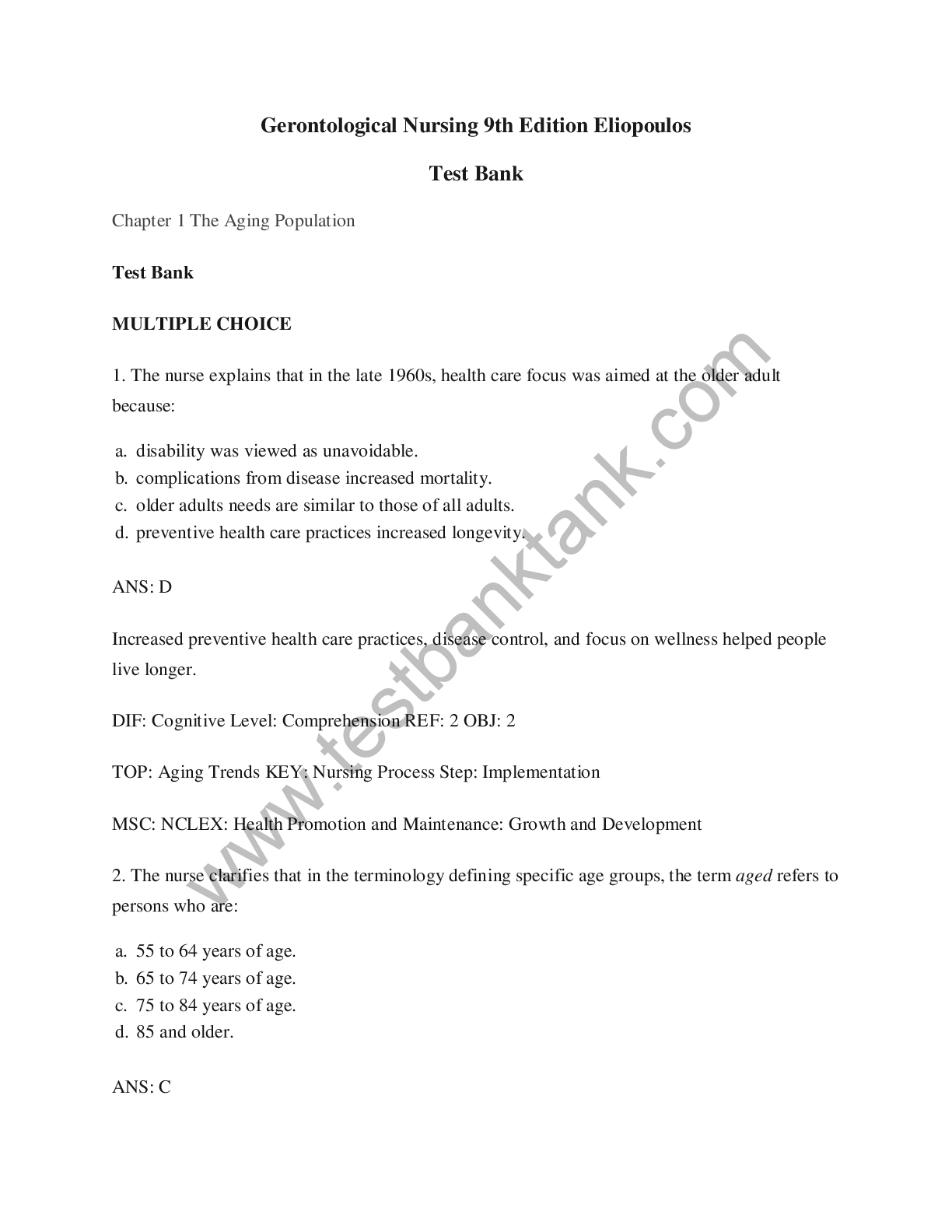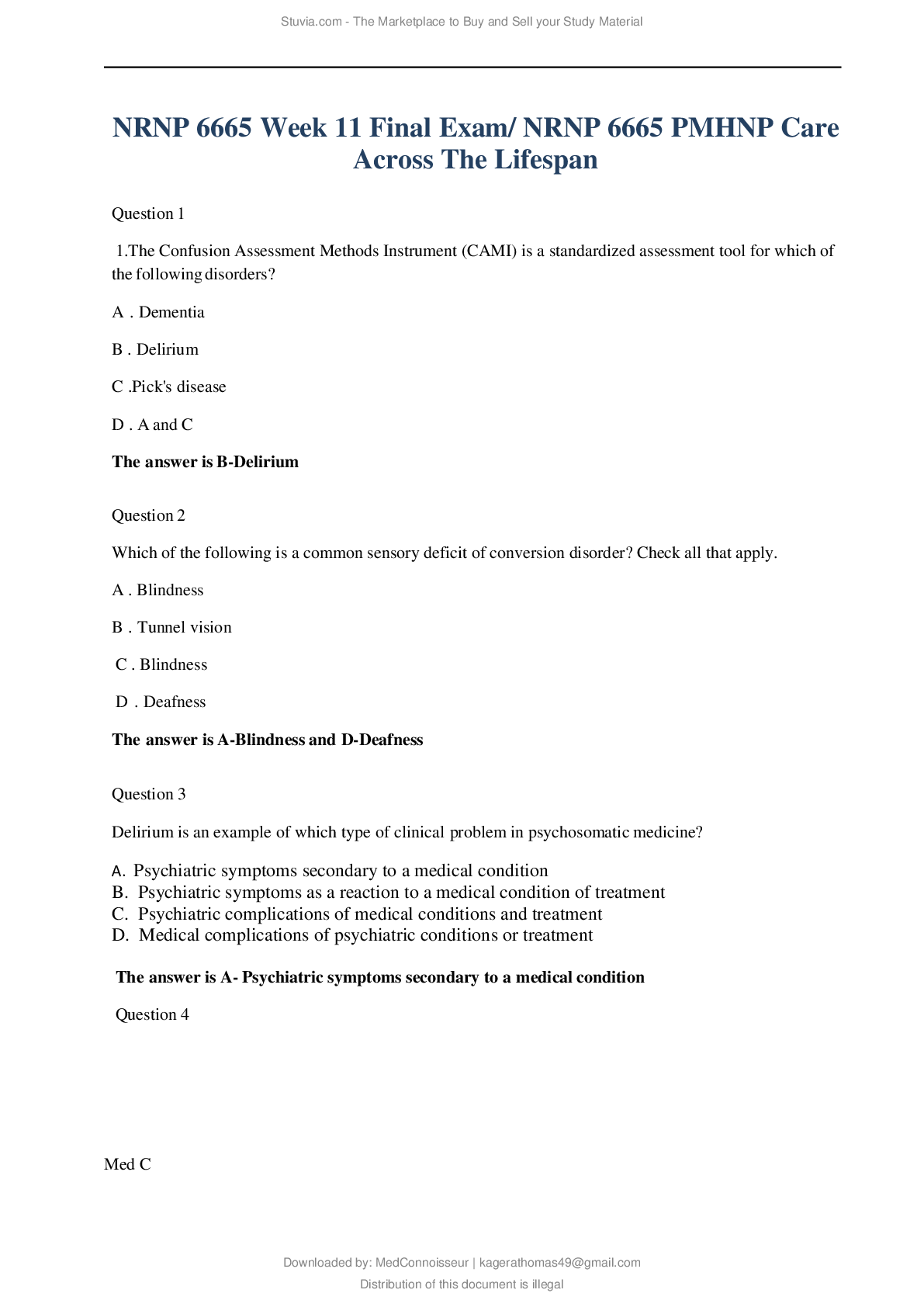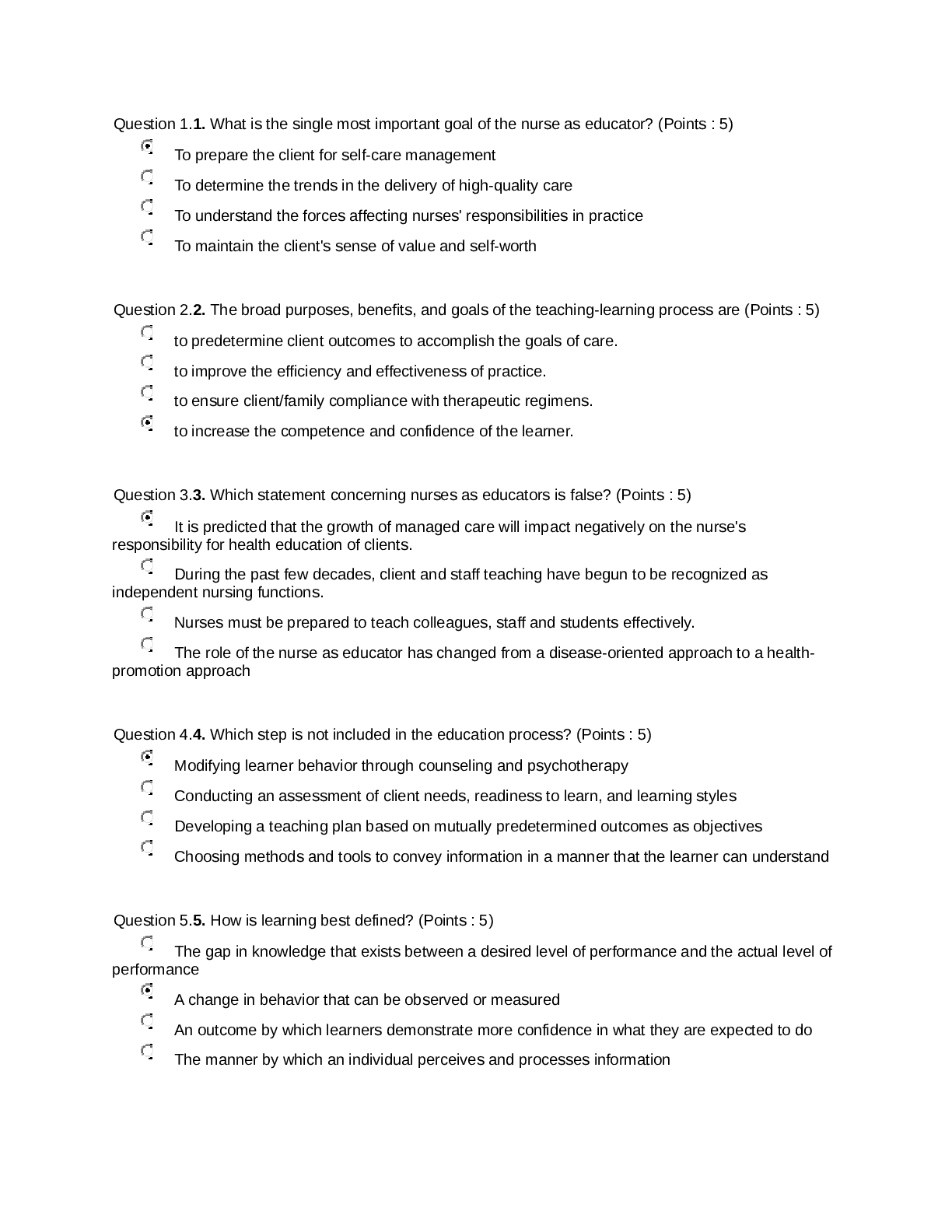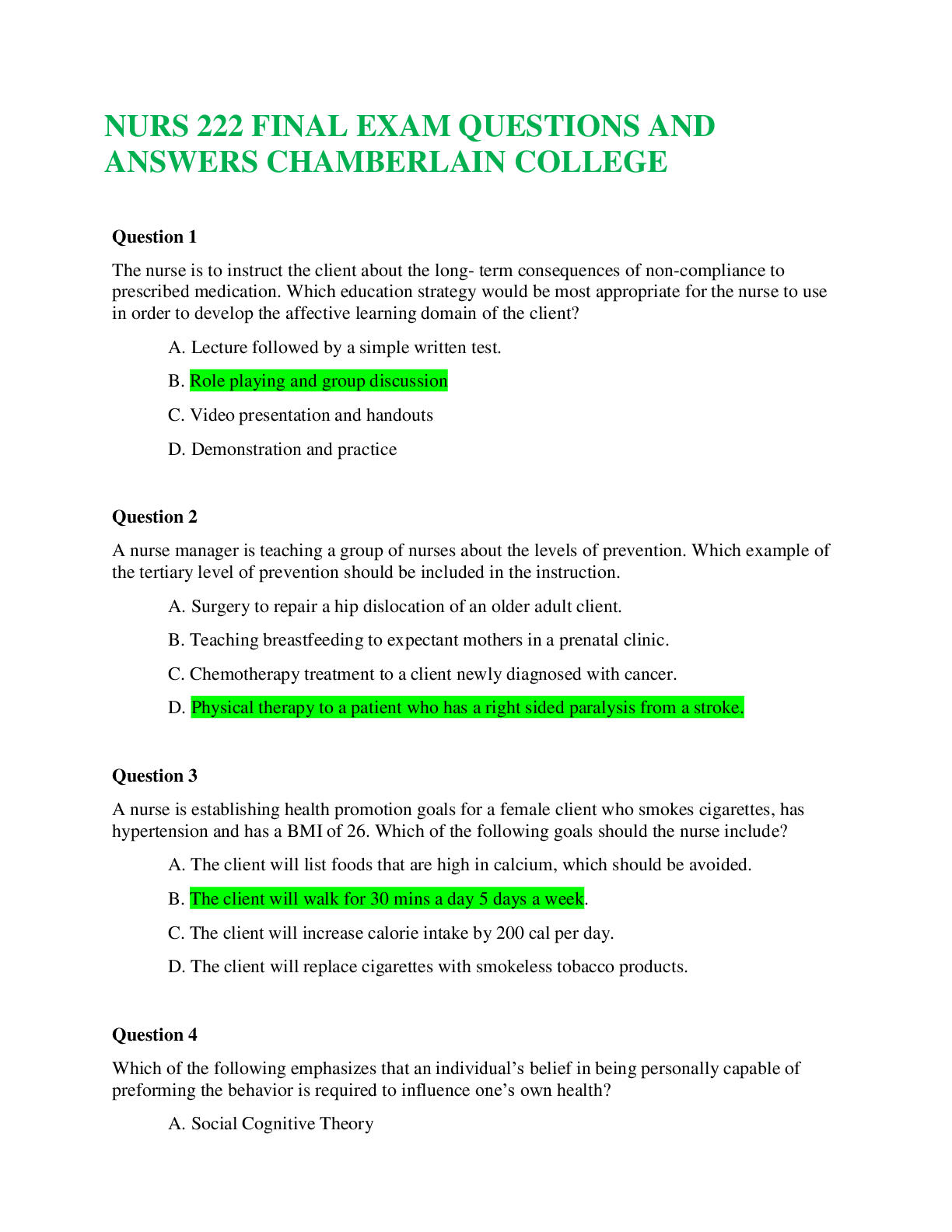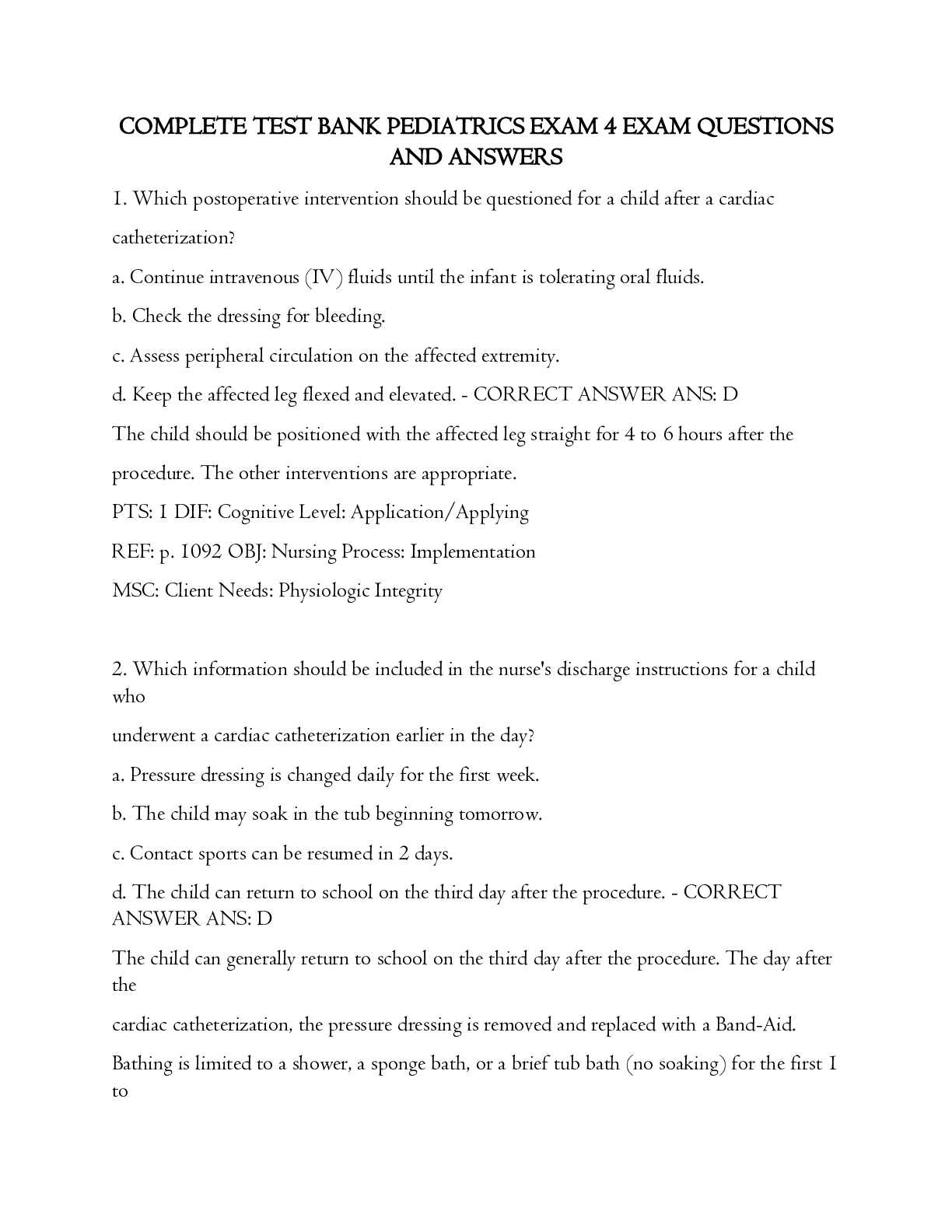*NURSING > TEST BANK > NRNP 6531 Exam Questions And Answers( Complete Solution);TOP SCORE/.RATED A+ (All)
NRNP 6531 Exam Questions And Answers( Complete Solution);TOP SCORE/.RATED A+
Document Content and Description Below
Question 1 1 out of 1 points Janine, age 29, has numerous transient lesions that come and go, and she is diagnosed with urticaria. What do you order? Selected Answer: d. Antihistami nes A nswers: ... a. Aspirin b. NSAIDs c. Opioids d. Antihistami nes Question 2 1 out of 1 points Medicare is a federal program administered by the Centers for Medicare and Medicaid Services (CMS). The CMS has developed guidelines for Evaluation and Management coding, which all providers are expected to follow when coding patient visits for reimbursement. Which of the following is an important consideration regarding billing practices? Selected Answer: c. Failing to bill for billable services will lead to unnecessarily low revenues Answers: a. It is important to “undercode” so that one does not get charged with Medicare fraud b. The practice of “overcoding” is essential in this age of decreasing reimbursements c. Failing to bill for billable services will lead to unnecessarily low revenues d. Time spent with the patient is a very important determinant of billing Question 3 0 out of 1 points What conditions must be met for you to bill “incident to” the physician, receiving 100% reimbursement from Medicare? Selected Answer: a. You must initiate the plan of care for the patient Answers: a. You must initiate the plan of care for the patient b. The physician must be on-site and engaged in patient care c. You must be employed as an independent contractor d. You must be the main health care provider who sees the patient Question 4 1 out of 1 points A 45 year old with diabetes has had itching and burning lesions between her toes for 2 months. Scrapings of the lesions confirm the diagnosis tinea pedis. What is the best initial treatment option for this patient? Selected Answer: Prescribe an antifungal powder for application between her toes and in her shoes and a topical prescription strength antifungal cream for other affected areas. Monitor for a secondary bacterial infection. Answers: Prescribe an antifungal powder for application between her toes and in her shoes and a topical prescription strength antifungal cream for other affected areas. Monitor for a secondary bacterial infection. Prescribe an oral antifungal for 4 to 12 weeks. Monitor BUN and creatinine at 1 week, 2 weeks, and every month thereafter. Prescribe an oral antifungal for 4 to 12 weeks. Monitor liver enzymes, BUN, and creatnine at 1 week, 2 weeks, and every month thereafter. Prescribe a prescription strength antifungal/steroid combination cream. Monitor for a secondary bacterial infection. Question 5 1 out of 1 points The Centor criteria for diagnosis of Group A B-hemolytic streptococcus includes which of the following? Selected Answer: A and B only Answers: Fever history Tender, swollen anterior cervical lymph nodes Positive rapid antigen detection test A and B only A, B, and C Question 6 1 out of 1 points A 16 year old basketball player complains of itching in the crural folds, buttocks, and upper thighs. The lesions are well demarcated and are half-moon shaped. The area is red, irritated, and there are small breaks in the skin from scratching. What is this patient’s diagnosis and how should it be treated? Selected Answer: a. Tinea cruris; treat with a topical antifungal cream Answers: a. Tinea cruris; treat with a topical antifungal cream b. Eczema; treat with a topical steroid c. Scabies; treat with permethrin cream d. Syphilis; treat with penicillin Question 7 1 out of 1 points Stacy, age 27, states that she has painless, white, slightly raised patches in her mouth. They are probably caused by: Selected Answer: c. Candidiasis Answers: a. Herpes simplex b. Aphthous ulcers c. Candidiasis d. Oral cancer Question 8 1 out of 1 points Marvin has sudden eye redness that occurred after a strenuous coughing episode. You diagnose a subconjunctival hemorrhage. Your next step is to Selected Answer: c. Do nothing other than provide reassurance Answers: a. Refer him to an ophthalmologist b. Order antibiotics c. Do nothing other than provide reassurance d. Consult with your collaborating physician Question 9 1 out of 1 points Your well-nourished 75-year-old patient has come into the office for a physical exam and states that she recently had two nosebleeds. She does not take any anticoagulants, and you have ruled out any coagulopathies. The most likely cause of these nosebleeds is: Selected Answer: b. Trauma or inflammation Answers: a. Sex hormones b. Trauma or inflammation c. A dietary change d. Scurvy Question 10 1 out of 1 points Your 31-year-old patient, whose varicella rash just erupted yesterday, asks you when she can go back to work. What do you tell her? Selected Answer: a. Once all the vesicles are crusted over Answers: a. Once all the vesicles are crusted over b. When the rash is entirely gone c. Once you have been on medication for at least 48 hours d. Now, as long as you stay away from children and pregnant women Question 11 1 out of 1 points A patient comes in complaining of 1 week of pain in the posterior neck with difficulty turning the head to the right. What additional history is needed? Selected Answer: Any recent trauma Answers: Any recent trauma Difficulty swallowing Stiffness in the right shoulder Change in sleeping habits Question 12 1 out of 1 points Which of the following is a predisposing condition for furunculosis? Selected Answer: a. Diabetes mellitus Answers: a. Diabetes mellitus b. Hypertension c. Peripheral vascular disease d. Chronic fatigue syndrome Question 13 1 out of 1 points Sylvia, age 83, presents with a 3 day history of pain and burning in the left forehead. This morning she noticed a rash with erythematous papules in that site. What do you suspect? Selected Answer: b. Herpes zoster Answers: a. Varicella b. Herpes zoster c. Syphilis d. Rubella Question 14 1 out of 1 points Sarah has allergic rhinitis and is currently being bothered by nasal congestion. Which of the following meds ordered for allergic rhinitis would be most appropriate? Selected Answer: A decongestant nasal spray Answers: An antihistamine intranasal spray A decongestant nasal spray Ipratropium Omalizumab Question 15 1 out of 1 points Larry, age 66, is a smoker with hyperlipidemia and hypertension. He is 6 months post-MI. To prevent reinfarction, the most important behavior change that he can make is to: Selected Answer: a. Quit smoking Answers: a. Quit smoking b. Maintain aggressive hypertension therapy c. Stick to a low-fat, low-sodium diet d. Continue with his exercise program Question 16 1 out of 1 points Harvey has had Meniere’s disease for several years. He has some hearing loss but now has persistent vertigo. What treatment might be instituted to relieve the vertigo? Selected Answer: c. A vestibular neurectomy Answers: a. Pharmacological therapy b. A labyrinthectomy c. A vestibular neurectomy d. Wearing an earplug in the ear with the most hearing loss Question 17 1 out of 1 points A 55 year old man is diagnosed with basal cell carcinoma. The nurse practitioner correctly tells him: Selected Answer: b. “It can be cured with surgical excision or radiation therapy.” Answers: a. “It is the most common cause of death in patients with skin cancer.” b. “It can be cured with surgical excision or radiation therapy.” c. “It is a slow growing skin cancer that rarely undergoes malignant changes.” d. “It can be cured using 5-flurouracil cream twice daily for 2 to 4 weeks.” Question 18 1 out of 1 points If a patient presents with a deep aching, red eye and there is no discharge, you should suspect: Selected a. Answer: Iritis Answers: a. Iritis b. Allergic conjunctivitis c. Viral conjunctivitis d. Bacterial conjunctivitis Question 19 1 out of 1 points Carl, age 78, is brought to the office by his son, who states that his father has been unable to see clearly since last night. Carl reports that his vision is “like looking through a veil.” He also sees floaters and flashing lights but is not having any pain. What do you suspect? Selected Answer: c. Retinal detachment Answers: a. Cataracts b. Glaucoma c. Retinal detachment d. Iritis Question 20 1 out of 1 points Which of the following statements about malignant melanomas is true? Selected Answer: d. The prognosis is directly related to the thickness of the lesion Answers: a. They usually occur in older adult males b. The patient has no family history of melanoma c. They are common in blacks d. The prognosis is directly related to the thickness of the lesion Question 1 0 out of 1 points Which drug category contains the drugs that are the first line Gold standard therapy for COPD? Selected Answer: c. Inhaled anticholinergic bronchodilators Answers: a. Corticosteroids b. Inhaled beta-2 agonist bronchodilators c. Inhaled anticholinergic bronchodilators d. Xanthines Question 2 1 out of 1 points What condition is associated with mucus production greater than 3 months per year for at least 2 consecutive years? Selected Answer: d. Chronic bronchitis Answers: a. Asthma b. Emphysema c. Chronic obstructive lung disease d. Chronic bronchitis Question 3 1 out of 1 points A 57-year-old male presents to urgent care complaining of substernal chest discomfort for the past hour. The EKG reveals ST elevations in Leads II, III, and AVF. The nurse practitioner is aware that these changes are consistent with which myocardial infarction territory? Selected Answer: a. Inferior wall Answers: a. Inferior wall b. Anterior wall c. Apical wall d. Lateral wall Question 4 1 out of 1 points Antibiotic administration has been demonstrated to be of little benefit to the treatment of which of the following disease processes? Selected Answer: b. Acute bronchitis Answers: a. Chronic sinusitis b. Acute bronchitis c. Bacterial pneumonia d. Acute exacerbation of chronic bronchitis Question 5 1 out of 1 points A patient presents to urgent care complaining of dyspnea, fatigue, and lower extremity edema. The echocardiogram reveals and ejection fraction of 38%. The nurse practitioner knows that these findings are consistent with: Selected Answer: b. Systolic heart failure Answers: a. Mitral regurgitation b. Systolic heart failure c. Cardiac myxoma d. Diastolic heart failure Question 6 1 out of 1 points Which of the following best describes hypertrophic cardiomyopathy? Selected Answer: c. Enlarged left ventricle and septum Answers: a. A weakened and enlarged myocardium b. Poor ventricular filling and weakened myocardium c. Enlarged left ventricle and septum d. None of the above Question 7 1 out of 1 points Harriet, a 79-year-old woman, comes to your office every 3 months for follow up on her hypertension. Her medications include one baby aspirin daily, Lisinopril 5mg daily, and Calcium 1500 mg daily. At today’s visit. Her blood pressure is 170/89. According to JNC VIII guidelines, what should you do next to control Harriet’s blood pressure? Selected Answer: b. Add a thiazide diuretic to the Lisinopril 5mg daily Answers: a. Increase her Lisinopril to 20mg daily b. Add a thiazide diuretic to the Lisinopril 5mg daily c. Discontinue the Lisinopril and start a combination of ACE Inhibitor and calcium channel blocker d. Discontinue the Lisinopril and start a diuretic Question 8 1 out of 1 points Which type of lung cancer has the poorest prognosis? Selected Answer: c. Small cell carcinoma Answers: a. Adenocarcinoma b. Epidermoid carcinoma c. Small cell carcinoma d. Large cell carcinoma Question 9 1 out of 1 points Which of the following medication classes should be avoided in patients with acute or chronic bronchitis because it will contribute to ventilation-perfusion mismatch in the patient? Selected Answer: b. Antihistimine s Answers: a. Xanthines b. Antihistimine s c. Steroids d. Anticholinerg ics Question 10 1 out of 1 points The most common correlate(s) with chronic bronchitis and emphysema is(are): Selected Answer: b. Cigarette smoking Answers: a. Familial and genetic factors b. Cigarette smoking c. Air pollution d. Occupational environment Question 11 0 out of 1 points A patient presents to the office with a blood pressure 142/80. This patient is classified as having: Selected d. Answer: Stage 2 hypertension Answers: a. Normal blood pressure b. Prehypertension c. Stage 1 hypertension d. Stage 2 hypertension Question 12 1 out of 1 points Salmeterol (Servent) is prescribed for a patient with asthma. What is the most important teaching point about this medication? Selected Answer: a. It is not effective during an acute asthma attack. Answers: a. It is not effective during an acute asthma attack. b. It may take 2 to 3 days to begin working. c. This drug works within 10 minutes. d. This drug may be used by patients 6 years and older. Question 13 1 out of 1 points Other than smoking cessation, which of the following slows the progression of COPD in smokers? Selected Answer: c. Engaging in moderate to high levels of physical activity Answers: a. Making sure the environment is free of all pollutants b. Eliminating all pets from the environment c. Engaging in moderate to high levels of physical activity d. Remaining indoors with air conditioning as much as possible Question 14 1 out of 1 points In order to decrease deaths from lung cancer: Selected Answer: d. Patients should be counseled to quit smoking Answers: a. All smokers should be screened annually b. All patients should be screened annually c. Only high risk patients should be screened routinely d. Patients should be counseled to quit smoking Question 15 0 out of 1 points An 8 year old presents to the health clinic with history of acute onset severe sore throat and respiratory distress with stridor in the last 2 hours. The child’s history is positive for fever and pharyngitis for 2 days. What is the most likely diagnosis? Selected Answer: a. Mononucleosis Answers: a. Mononucleosis b. Asthma c. Respiratory syncytial virus (RSV) d. Epiglottitis Question 16 1 out of 1 points A 20 year old is diagnosed with mild persistent asthma. What drug combination would be most effective in keeping him symptom-free? Selected Answer: d. A bronchodilator PRN and an inhaled corticosteroid Answers: a. A long-acting bronchodilator b. An inhaled corticosteroid and cromolyn c. Theophylline and a short acting bronchodilator d. A bronchodilator PRN and an inhaled corticosteroid Question 17 1 out of 1 points Which of the following is not a risk factor for coronary arterial insufficiency? Selected Answer: d. Alcohol ingestion Answers: a. Hyperhomocystein emia b. Smoking c. Genetic factors d. Alcohol ingestion Question 18 1 out of 1 points Which of the following patient characteristics are associated with chronic bronchitis? Selected Answer: a. Overweight, cyanosis, and normal or slightly increased respiratory rate Answers: a. Overweight, cyanosis, and normal or slightly increased respiratory rate b. Underweight, pink skin, and increased respiratory rate c. Overweight, pink skin, and normal or slightly increased respiratory rate d. Normal weight, cyanosis, and greatly increased respiratory rate Question 19 0 out of 1 points Management of a patient with hypertension and an abdominal aortic aneurysm would include: Selected Answer: b. changing the patient’s BP medications Answers: a. computed tomography scan without contrast b. changing the patient’s BP medications c. referral to a cardiologist d. immediate cardiac catheterization Question 20 1 out of 1 points Which of the following is not a goal of treatment for the patient with cystic fibrosis? Selected Answer: d. Replace water-soluble vitamins Answers: a. Prevent intestinal obstruction b. Provide adequate nutrition c. Promote clearance of secretions d. Replace water-soluble vitamins Question 1 1 out of 1 points Which of the following patients most warrants screening for hypothyroidism? Selected Answer: d. An elderly female with recent onset of mental dysfunction. Answers: a. A young adult female with postpartum depression lasting 2 weeks. b. A patient taking thyroid replacement preparation. c. A 40 year old male with unexplained tremors. d. An elderly female with recent onset of mental dysfunction. Question 2 1 out of 1 points The nurse practitioner diagnoses epididymitis in a 24 year old sexually active male patient. The drug of choice for treatment of this patient is: Selected Answer: b. Oral doxycycline (Virbamycin) plus intramuscular ceftriaxone Answers: a. Oral ciprofloxacin (Cipro) b. Oral doxycycline (Virbamycin) plus intramuscular ceftriaxone c. Oral trimethoprim-sulfamethoxazole (Bactrim DS) d. Intramuscular penicillin Question 3 1 out of 1 points The most commonly recommended method for prostate cancer screening in a 55 year old male is: Selected Answer: a. Digital rectal examination (DRE) plus prostate specific antigen (PSA) Answers: a. Digital rectal examination (DRE) plus prostate specific antigen (PSA) b. Prostate specific antigen (PSA) alone c. Transrectal ultrasound (TRUS) alone d. Prostate specific antigen (PSA) and transrectal ultrasound (TRUS) Question 4 1 out of 1 points John, age 33, has a total cholesterol level of 188 mg/dL. How often should he be screened for hypercholesterolemia? Selected Answer: a. Every 5 years Answers: a. Every 5 years b. Every 2 years c. Every year d. Whenever blood work is done Question 5 1 out of 1 points The National Cholesterol Education Program’s Adult Treatment Panel III recommends that the goal for low density lipoproteins in high risk patients be less than: Selected Answer: c. 100 mg/dL Answers: a. 160 mg/dL b. 130 mg/dL c. 100 mg/dL d. 70 mg/dL Question 6 1 out of 1 points A patient presents with classic symptoms of gastroesophageal reflux disease (GERD). He is instructed on life style modifications and drug therapy for 8 weeks. Three months later he returns, reporting that he was “fine” as long as he took the medication. The most appropriate next step is: Selected Answer: d. Investigation with endoscopy, manometry, and/or pH testing Answers: a. Referral for surgical intervention such as a partial or complete fundoplication b. Dependent upon how sever the practitioner believes the condition c. To repeat the 8 week course of drug therapy while continuing lifestyle modifications d. Investigation with endoscopy, manometry, and/or pH testing Question 7 0 out of 1 points Which of the following is not appropriate suppression therapy for chronic bacterial prostatitis? Selected Answer: b. Nitrofurantoin 100 mg qd Answers: a. Doxycycline 100 mg qd b. Nitrofurantoin 100 mg qd c. Bactrim DS qd d. Erythromycin qd Question 8 1 out of 1 points Of the following choices, the least likely cause of cough is: Selected Answer: c. Acute pharyngitis Answers: a. Asthma b. Gastroesophageal reflux c. Acute pharyngitis d. Allergic rhinitis Question 9 0 out of 1 points Which of the following is not a common early sign of benign prostatic hyperplasia (BPH)? Selected Answer: c. Urinary retention Answers: a. Difficulty initiating a urine stream b. Nocturia c. Urinary retention d. Increased force of urine flow Question 10 0 out of 1 points A patient has been diagnosed with hypothyroidism and thyroid hormone replacement therapy is prescribed. How long should the nurse practitioner wait before checking the patient’s TSH? Selected Answer: d. 8 weeks Answers: a. 1 week b. 2 weeks c. 4 weeks d. 8 weeks Question 11 1 out of 1 points A 20 year old male patient complains of “scrotal swelling.” He states his scrotum feels heavy, but denies pain. On examination, the nurse practitioner notes transillumination of the scrotum. What is the most likely diagnosis? Selected Answer: b. Hydrocele Answers: a. Indirect inguinal hernia b. Hydrocele c. Orchitis d. Testicular torsion Question 12 1 out of 1 points Before initiating an HMG CoA-reductase inhibitor for hyperlipidemia, the nurse practitioner orders liver function studies. The patient’s aminotransferase (ALT) is elevated. What laboratory test(s) should be ordered? Selected Answer: a. Serologic markers for hepatitis Answers: a. Serologic markers for hepatitis b. Serum bilirubin c. Serum cholesterol with HDL and LDL d. A liver biopsy Question 13 0 out of 1 points What is the most common cause of Cushing’s syndrome? Selected Answer: c. Pituitary adenoma or a non-pituitary ACTHproducing tumor Answers: a. Excessive ACTH production b. Administration of a glucocorticoid or ACTH c. Pituitary adenoma or a non-pituitary ACTHproducing tumor d. Autonomous cortisol production from adrenal tissue Question 14 1 out of 1 points Reed-Sternberg B lymphocytes are associated with which of the following disorders: Selected Answer: b. Hodgkin’s lymphoma Answers: a. Aplastic anemia b. Hodgkin’s lymphoma c. Non Hodgkin’s lymphoma d. Myelodysplastic syndromes Question 15 1 out of 1 points Which of the following is not a risk factor associated with the development of syndrome X and type 2 diabetes mellitus? Selected Answer: d. Postprandial hypoglycemia Answers: a. Hypertriglyceridemia and low high-density lipoprotein (HDL) b. Gestational diabetes and polycystic ovarian syndrome c. Hispanic, African-American, Native-American, and Pacific Islander ethnicity d. Postprandial hypoglycemia Question 16 1 out of 1 points Which of the following are classic features of ulcerative colitis? Selected Answer: d. Remissions and exacerbations of bloody diarrhea, tenesmus, fecal incontinence, abdominal pain and weight loss. Answers: a. Right lower quadrant pain, frequently accompanied by a palpable mass, fever, and leukocytosis. b. Painful hematemesis, occasionally accompanied by melena. c. Rapidly progressive dysphagia with ingestion of solid foods, anorexia, and weight loss out of proportion to the dysphagia. d. Remissions and exacerbations of bloody diarrhea, tenesmus, fecal incontinence, abdominal pain and weight loss. Question 17 1 out of 1 points Diagnostic confirmation of acute leukemia is based on: Selected Answer: a. Bone marrow aspiration and biopsy Answers: a. Bone marrow aspiration and biopsy b. Pancytopenia c. Hyperuricemia d. All of the above Question 18 0 out of 1 points After thorough history, physical examination, and laboratory tests, a patient is diagnosed with irritable bowel syndrome (IBS). Which of the following initial treatment plans is currently considered most effective? Selected Answer: c. Treatment with a selective serotonin reuptake inhibitor (SSRI) such as fluoxetine (Prozac) or sertraline (Zoloft). Answers: a. A low fat, tyramine-free, caffeine-free, high fiber diet, along with a daily diary, and attention to psychosocial factors. b. Referral to a gastroenterologist for colonoscopy. c. Treatment with a selective serotonin reuptake inhibitor (SSRI) such as fluoxetine (Prozac) or sertraline (Zoloft). d. Antibiotics, nutritional support, and high fiber diet. Question 19 1 out of 1 points Steve, age 69, has gastroesophageal reflux disease (GERD). When teaching him how to reduce his lower esophageal sphincter pressure, which substances do you recommend that he avoid? Selected Answer: b. Pepperm int Answers: a. Apples b. Pepperm int c. Cucumb ers d. Popsicles Question 20 1 out of 1 points Microalbuminuria is a measure of: Selected Answer: d. Protein lost into the urine. Answers: a. Total urinary protein. b. Late renal compromise in a diabetic patient. c. Early glycemic abnormality. d. Protein lost into the urine. Question 1 1 out of 1 points A patient taking levothyroxine is being over-replaced. What condition is he at risk for? Selected Answer: a. Osteoporo sis Answers: a. Osteoporo sis b. Constipati on c. Depressio n d. Exopthal mia Question 2 1 out of 1 points The most effective treatment of non-infectious bursitis includes: Selected Answer: b. Rest, an intra-articular corticosteroid injection, and a concomitant oral NSAID. Answers: a. Systemic antibiotic therapy effective against penicillin resistant Staphylococcus areus. b. Rest, an intra-articular corticosteroid injection, and a concomitant oral NSAID. c. A tapering regimen of oral corticosteroid therapy. d. Frequent active range of joint motion. Question 3 1 out of 1 points A typical description of a tension headache is: Selected Answer: b. Bilateral, occipital, or frontal tightness or fullness, with waves of aching pain. Answers: a. Periorbital pain, sudden onset, often explosive in quality, and associated with nasal stuffiness, lacrimation, red eye, and nausea. b. Bilateral, occipital, or frontal tightness or fullness, with waves of aching pain. c. Hemicranial pain that is accompanied by vomiting and photophobia. d. Steadily worsening pain that interrupts sleep, is exacerbated by orthostatic changes, and may be preceded by nausea and vomiting. Question 4 1 out of 1 points Diagnostic radiological studies are indicated for low back pain: Selected Answer: c. When there is a suspicion of a space-occupying lesion, fracture, cauda equina, or infection. Answers: a. Routinely after 3 weeks of low back pain symptoms. b. To screen for spondylolithiasis in patients less than 20 years of age with 2 weeks of more of low back pain. c. When there is a suspicion of a space-occupying lesion, fracture, cauda equina, or infection. d. As a part of a pre-employment physical when heavy lifting is included in the job description. Question 5 1 out of 1 points A 60 year old female patient complains of sudden onset unilateral, stabbing, surface pain in the lower part of her face lasting a few minutes, subsiding, and then returning. The pain is triggered by touch or temperature extremes. Physical examination is normal. Which of the following is the most likely diagnosis? Selected Answer: a. Trigeminal neuralgia Answers: a. Trigeminal neuralgia b. Temporal arteritis c. Parotiditis d. Bell’s palsy Question 6 1 out of 1 points A 72 year old patient exhibits sudden onset of fluctuating restlessness, agitation, confusion, and impaired attention. This is accompanied by visual hallucinations and sleep disturbance. What is the most likely cause of this behavior? Selected Answer: b. Delirium Answers: a. Dementia b. Delirium c. Medication reaction d. Depression Question 7 1 out of 1 points Phalen’s test, 90°wrist flexion for 60 seconds, reproduces symptoms of: Selected Answer: b. Carpal tunnel syndrome Answers: a. Ulnar tunnel syndrome b. Carpal tunnel syndrome c. Tarsal tunnel syndrome d. Myofascial pain syndrome Question 8 1 out of 1 points The most commonly recommended pharmacological treatment regimen for low back pain (LBP) is: Selected Answer: a. Acetaminophen or an NSAID Answers: a. Acetaminophen or an NSAID b. A muscle relaxant as an adjunct to an NSAID c. An oral corticosteroid and diazepam (Valium) d. Colchicine and an opioid analgesic Question 9 1 out of 1 points A 26 year old female presents with elbow pain that is described as aching and burning. There is point tenderness along the lateral aspect of the elbow and painful passive flexion and extension. She reports she has been playing tennis almost daily for the past month. The most likely diagnosis is: Selected Answer: d. Lateral epicondylitis Answers: a. Radial tunnel syndrome b. Ulnar collateral ligament sprain c. Olecranon bursitis d. Lateral epicondylitis Question 10 1 out of 1 points A positive drawer sign supports a diagnosis of: Selected Answer: b. Cruciate ligament injury Answers: a. Sciatica b. Cruciate ligament injury c. Meniscal injury d. Patellar ligament injury Question 11 1 out of 1 points The most effective intervention(s) to prevent stroke is (are): Selected Answer: d. Smoking cessation and treatment of hypertension Answers: a. 81 mg of aspirin daily b. Carotid endarterectomy for patients with high-grade carotid lesions c. Routine screening for carotid artery stenosis with auscultation for bruits d. Smoking cessation and treatment of hypertension Question 12 1 out of 1 points The diagnosis which must be considered in a patient who presents with a severe headache of sudden onset, with neck stiffness and fever, is: Selected Answer: d. Meningitis Answers: a. Migraine headache b. Subarachnoid hemorrhage c. Glaucoma d. Meningitis Question 13 1 out of 1 points The correct treatment for ankle sprain during the first 48 hours after injury includes: Selected Answer: c. Rest, elevation, compression, ice and pain relief. Answers: a. Alternating heat and ice, and ankle exercises. b. Resistive ankle exercises, ankle support, and pain relief. c. Rest, elevation, compression, ice and pain relief. d. Referral to an orthopedist after x-rays to rule out fracture. Question 14 1 out of 1 points Which of the following symptoms suggests a more serious cause of back pain? Selected Answer: c. Pain associated with lying down at night Answers: a. Pain associated with coughing or sneezing b. Pain associated with muscle spasm c. Pain associated with lying down at night d. Pain associated with negative straight leg raise Question 15 0 out of 1 points The most reliable indicator(s) of neurological deficit when assessing a patient with acute low back pain is(are): Selected Answer: c. Decreased reflexes, strength, and sensation in the lower extremities. Answers: a. Patient report of bladder dysfunction, saddle anesthesia, and motor weakness of limbs. b. History of significant trauma relative to the patient’s age. c. Decreased reflexes, strength, and sensation in the lower extremities. d. Patient report of pain with the crossed straight leg raise. Question 16 0 out of 1 points Which of the following set of symptoms should raise suspicion of a brain tumor? Selected Answer: a. Recurrent, severe headaches that awaken the patient and are accompanied by visual disturbances. Answers: a. Recurrent, severe headaches that awaken the patient and are accompanied by visual disturbances. b. Vague, dull headaches that are accompanied by a reported sense of impending doom. c. Periorbital headaches occurring primarily in the evening and accompanied by pupillary dilation and photophobia. d. Holocranial headaches present in the morning and accompanied by projective vomiting without nausea. Question 17 1 out of 1 points Successful management of a patient with attention deficit hyperactivity disorder (ADHD) may be achieved with: Selected Answer: a. Stimulant medication along with behavioral and family intervention. Answers: a. Stimulant medication along with behavioral and family intervention. b. Methylphenidate (Ritalin) in conjunction with diet changes. c. Treatment by a psychiatrist. d. Discipline and removal of offending foods from the diet. Question 18 1 out of 1 points Which of the following statements about multiple sclerosis (MS) is correct? Selected Answer: c. MS is a chronic, treatable illness with unknown cause and a variable course. Answers: a. MS is a chronic, untreatable illness that is almost always fatal. b. MS is a disease of steadily progressive and unrelenting neurologic deterioration. c. MS is a chronic, treatable illness with unknown cause and a variable course. d. Patients with MS who take active steps to improve their health have the best cure rate. Question 19 1 out of 1 points The most common symptoms of transient ischemic attack (TIA) include: Selected Answer: b. Weakness in an extremity, abruptly slurred speech, or partial loss of vision, and sudden gait changes. Answers: a. Nausea, vomiting, syncope, incontinence, dizziness, and seizure. b. Weakness in an extremity, abruptly slurred speech, or partial loss of vision, and sudden gait changes. c. Headache and visual symptoms such as bright spots or sparkles crossing the visual field. d. Gradual onset of ataxia, vertigo, generalized weakness, or lightheadedness Question 20 0 out of 1 points The 4 classic features of Parkinson’s disease are: Selected Answer: b. Tremor at rest, rigidity, bradykinesia, and postural disturbances. Answers: a. Mask-like facies, dysarthria, excessive salivation, and dementia. b. Tremor at rest, rigidity, bradykinesia, and postural disturbances. c. Depression, cognitive impairment, constipation and shuffling gait. d. Tremor with movement, cogwheeling, repetitive movement, and multi-system atrophy. The most common cancer found on the auricle is: Basal Cell Carcinoma Which of the following medication classes should be avoided in patients with acute or chronic bronchitis because it will contribute to ventilation-perfusion mismatch in the patient? Xanthines Antihistimines Steroids Anticholinergics Antihistamines A 47 year old male patient presents to the clinic with a single episode of a moderate amount of bright red rectal bleeding. On examination, external hemorrhoids are noted. How should the nurse practitioner proceed? Instruct the patient on measures to prevent hemorrhoids such as bowel habits and diet. Order a topical hemorrhoid cream along with a stool softener. Refer the patient for a barium enema and sigmoidoscopy. Refer the patient for a surgical hemorrhoidectomy. Refer the patient for a barium enema and sigmoidoscopy. Which of the following patient characteristics are associated with chronic bronchitis? Overweight, cyanosis, and normal or slightly increased respiratory rate Underweight, pink skin, and increased respiratory rate Overweight, pink skin, and normal or slightly increased respiratory rate Normal weight, cyanosis, and greatly increased respiratory rate Overweight, cyanosis, and normal or slightly increased respiratory rate A 65-year-old female with a past medical history of hypertension, hyperlipidemia, and polymyalgia rheumatica presents to urgent care with new onset left lower quadrant pain. Her current medications include omeprazole 20 milligrams po daily, lisinopril 20 milligrams po daily, simvastatin 20 milligrams po daily, and prednisone 12 milligrams po daily. The nurse practitioner suspects acute diverticulitis and possibly an abscess. The most appropriate diagnostic test for this patient at this time is: CBC/diff Erythrocyte sedimentation rate Abdominal ultrasound CT scan CT scan A patient reports "something flew in my eye" about an hour ago while he was splitting logs. If there were a foreign body in his eye, the nurse practitioner would expect to find all except: Purulent drainage Tearing Photophobia A positive fluorescein stain Purulent drainage A 21 year old college student presents to the student health center with copious, markedly purulent discharge from her left eye. The nurse practitioner student should suspect: Viral conjunctivitis Common pink eye Gonococcal conjunctivitis Allergic conjunctivitis Gonococcal conjunctivitis A 35 year old man presents with radicular pain followed by the appearance of grouped vesicles consisting of about 15 lesions across 3 different thoracic dermatomes. He complains of pain, burning, and itching. The nurse practitioner should suspect: A common case of shingles and prescribe an analgesic and an antiviral agent A complicated case of shingles and prescribe acyclovir, an analgesic, and a topical cortisone cream Herpes zoster and consider that this patient may be immunocompromised A recurrence of chickenpox and treat the patient's symptoms Herpes zoster and consider that this patient may be immunocompromised Which type of lung cancer has the poorest prognosis? Adenocarcinoma Epidermoid carcinoma Small cell carcinoma Large cell carcinoma Small cell carcinoma An 83-year-old female presents to the office complaining of diarrhea for several days. She explains she has even had fecal incontinence one time. She describes loose stools 3-4 times a day for several weeks and denies fever, chills, pain, recent antibiotic use. The history suggests that the patient has: Acute diarrhea Chronic diarrhea Irritable bowel Functional bowel disease Chronic diarrhea Margaret, age 32, comes into the office with painful joints and a distinctive rash in a butterfly distribution on her face. The rash has red papules and plaques with a fine scale. What do you suspect? An allergic reaction Relapsing polychondritis Lymphocytoma cutis Systemic lupus erythematosus Systemic lupus erythematosus Antibiotic administration has been demonstrated to be of little benefit to the treatment of which of the following disease processes? Chronic sinusitis Acute bronchitis Bacterial pneumonia Acute exacerbation of chronic bronchitis Acute bronchitis 00:0101:24 Upgrade to remove ads Only $2.99/month Lisa, age 49, has daily symptoms of asthma. She uses her inhaled short-acting beta-2 agonist daily. Her exacerbations affect her activities and they occur at least twice weekly and may last for days. She is affected more than once weekly during the night with an exacerbation. Which category of asthma severity is Lisa in? Mild intermittent Mild persistent Moderate persistent Moderate persistent Which of the following is the most appropriate therapeutic regimen for an adult patient with no known allergies diagnosed with group A B-hemolytic strep? Penicillin V 500 milligrams PO every 8 hours for 10 days Ampicillin 250 milligrams PO twice a day for 10 days Clarithromycin 500 milligrams po daily for 7 days None of the above Penicillin V 500 milligrams PO every 8 hours for 10 days A cashier complains of dull ache and pressure sensation in her lower legs. It is relieved by leg elevation. She occasionally has edema in her lower legs at the end of the day. What is the most likely cause of these problems? Congestive heart failure Varicose veins Deep vein thrombosis Arterial insufficiency Varicose veins Which statement below is correct about pertussis? It is also called whooping cough It begins with symptoms like strep throat It lasts about 3 weeks It occurs most commonly in toddlers and young children It is also called whooping cough Which of the following is the most important diagnosis to rule out in the adult patient with acute bronchitis? Pneumonia Asthma Sinusitis Pertussis Pneumonia A 70 year old patient presents with left lower quadrant (LLQ) abdominal pain, a markedly tender palpable abdominal wall, fever, and leukocytosis. Of the following terms, which correctly describes the suspected condition? Diverticulosis Diverticula Diverticulitis Diverticulum Diverticulitis Sylvia, age 83, presents with a 3 day history of pain and burning in the left forehead. This morning she noticed a rash with erythematous papules in that site. What do you suspect? Varicella Herpes zoster Syphilis Rubella Herpes zoster A 33-year-old female is admitted with acute pancreatitis. The nurse practitioner knows that the most common cause of pancreatitis is: Alcohol Gallstones Medications Pregnancy Gallstones When a patient presents with symptoms of acute gallbladder disease, what is the appropriate nurse practitioner action? Order abdominal x-rays Order an abdominal ultrasound Refer the patient to a surgeon for evaluation Prescribe pain medication Order an abdominal ultrasound A false-positive result with the fecal occult blood test can result from: ingestion of large amounts of vitamin C a high dietary intake of rare cooked beef a colonic neoplasm that is not bleeding stool that has been stored before testing a high dietary intake of rare cooked beef Upgrade to remove ads Only $2.99/month A 76-year-old male complains of weight loss, nausea, vomiting, abdominal cramping and pain. Physical findings include an abdominal mass and stool positive for occult blood. The nurse practitioner pain suspects a tumor in the small intestine. The best diagnostic test for this patient is: Colonoscopy Small bowel follow-through Barium enema CT abdomen Small bowel follow-through A patient presents to urgent care complaining of dyspnea, fatigue, and lower extremity edema. The echocardiogram reveals and ejection fraction of 38%. The nurse practitioner knows that these findings are consistent with: Mitral regurgitation Systolic heart failure Cardiac myxoma Diastolic heart failure Systolic heart failure Maxine, Age 76, has just been given a diagnosis of pneumonia. Which of the following is an indication that she should be hospitalized? Multilobar involvement on chest x-ray with the inability to take oral medications Alert and oriented, slightly high but stable vital signs, and no one to take care of her at home Sputum and gram positive organisms A complete blood count showing leukocytosis Multilobar involvement on chest x-ray with the inability to take oral medications A 55 year old man is diagnosed with basal cell carcinoma. The nurse practitioner correctly tells him: "It is the most common cause of death in patients with skin cancer." "It can be cured with surgical excision or radiation therapy." "It is a slow growing skin cancer that rarely undergoes malignant changes." "It can be cured using 5-flurouracil cream twice daily for 2 to 4 weeks." "It can be cured with surgical excision or radiation therapy." Expected spirometry readings when the patient has chronic emphysema include: Decreased residual volume (RV) Increased vital capacity (VC) Increased forced expiratory volume (FEV-1) Increased total lung capacity (TLC) Increased total lung capacity (TLC) An 80-year-old male admits to difficulty swallowing during the review of systems. The nurse practitioner recognizes the differential diagnosis for this patient's dysphagia is: Esophageal cancer Chest pain GERD A and C All of the above A and C A 40 year old female with history of frequent sun exposure presents with a multicolored lesion on her back. It has irregular borders and is about 11mm in diameter. What should the nurse practitioner suspect? Squamous cell carcinoma Malignant melanoma A common nevus Basal cell carcinoma Malignant melanoma Which of the following is not a goal of treatment for the patient with cystic fibrosis? Prevent intestinal obstruction Provide adequate nutrition Promote clearance of secretions Replace water-soluble vitamins Replace water-soluble vitamins The nurse practitioner is performing a physical exam on a middle-aged AfricanAmerican man. Which of the following areas is a common site for melanomas in AfricanAmericans and other dark-skinned individuals? Scalp Nails Feet B and C All of the above B and C An adult presents with tinea corporis. Which item below is a risk factor for its development? Topical steroid use Topical antibiotic use A recent laceration Cold climates Topical steroid use A patient has experienced nausea and vomiting, headache, malaise, low grade fever, abdominal cramps, and watery diarrhea for 72 hours. His white count is elevated with a shift to the left. He is requesting medication for diarrhea. What is the most appropriate response? Prescribe loperamide (Immodium) or atropine-diphenoxylate (Lomotil) and a clear liquid diet for 24 hours. Prescribe a broad-spectrum antibiotic such as ciprofloxacin (Cipro), and symptom management. Offer an anti-emetic medication such as ondansetron (Zofran) and provide oral fluid and electrolyte replacement instruction. Order stool cultures. Prescribe a broad-spectrum antibiotic such as ciprofloxacin (Cipro), and symptom management. Janine, age 29, has numerous transient lesions that come and go, and she is diagnosed with urticaria. What do you order? Aspirin NSAIDs Opioids Antihistamines Antihistamines Of the following signs and symptoms of congestive heart failure (CHF), the earliest clinical manifestation is: Peripheral edema Weight gain Shortness of breath Nocturnal dyspnea Weight gain A 16 year old male presents with mild sore throat, fever, fatigue, posterior cervical adenopathy, and palatine petechiae. Without a definitive diagnosis for this patient, what drug would be least appropriate to prescribe? Ibuprofen Erythromycin Amoxicillin Acetaminophen Amoxicillin A 70 year old man who walks 2 miles every day complains of pain in his left calf when he is walking. The problem has gotten gradually worse and now he is unable to complete his 2 mile walk. What question asked during the history, if answered affirmatively, would suggest a diagnosis of arteriosclerosis obliterans? "Are you wearing your usual shoes?" "Do you also have chest pain when you have leg pain?" "Is your leg pain relieved by rest?" "Do you ever have the same pain in the other leg?" "Is your leg pain relieved by rest?" Which of the following statements about malignant melanomas is true? They usually occur in older adult males The patient has no family history of melanoma They are common in blacks The prognosis is directly related to the thickness of the lesion The prognosis is directly related to the thickness of the lesion Sheila, age 78, presents with a chief complaint of waking up during the night coughing. You examine her and find an S3 heart sound, pulmonary crackles that do not clear with coughing, and peripheral edema. What do you suspect? Asthma Nocturnal allergies Valvular disease Heart failure Heart Failure Which antibiotic would be the most effective in treating community acquired pneumonia (CAP) in a young adult without any comorbid conditions? Erythromycin Clarithromycin (Biaxin) Doxycycline (Vibramycin) Penicillin Clarithromycin (Biaxin) Which of the following dermatologic vehicles are the most effective in absorbing moisture and decreasing friction? Powders Gels Creams Lotion Powders A 70 year old patient presents with a slightly raised, scaly, erythematous patch on her forehead. She admits to having been a "sun worshiper." The nurse practitioner suspects actinic keratosis. This lesion is a precursor to: Squamous cell carcinoma Basal cell carcinoma Malignant melanoma Acne vulgaris Squamous cell carcinoma Upgrade to remove ads Only $2.99/month An elderly patient is being seen in the clinic for complaint of "weak spells" relieved by sitting or lying down. How should the nurse practitioner proceed with the physical examination? Assist the patient to a standing position and take her blood pressure. Assess the patient's cranial nerves. Compare the patient's blood pressure lying first, then sitting, and then standing. Compare the amplitude of the patient's radial and pedal pulses. Compare the patient's blood pressure lying first, then sitting, and then standing. What oral medication might be used to treat chronic cholethiasis in a patient who is a poor candidate for surgery? Ursodiol Ibuprofen Prednisone Surgery is the only answer Ursodiol A 46-year-old female with a past medical history of diabetes presents with a swollen, erythematous right auricle and is diagnosed with malignant otitis externa. The nurse practitioner knows that the most likely causative organism for this patient's problem is: Staphylococcus aureus Group A beta hemolytic streptococcus Haemophilus influenza Pseudomonas aeruginosa Pseudomonas aeruginosa Which of the following is not a symptom of irritable bowel syndrome? Painful diarrhea Painful constipation Cramping and abdominal pain Weight loss Weight loss A patient comes in complaining of 1 week of pain in the posterior neck with difficulty turning the head to the right. What additional history is needed? Any recent trauma Difficulty swallowing Stiffness in the right shoulder Change in sleeping habits Any recent trauma Marvin, age 56, is a smoker with diabetes. He has just been diagnosed as hypertensive. Which of the following drugs has the potential to cause the development of bronchial asthma and inhibit gluconeogenesis? ACE Inhibitor Beta Blocker Calcium channel blocker Diuretic Beta Blocker The differential diagnosis for a patient complaining of a sore throat includes which of the following? Gonococcal infection Thrush Leukoplakia B only A, B, and C A, B, and C A patient presents to the primary care provider complaining of a rash on his right forehead that started yesterday and is burning and painful. The physical exam reveals an erythematous, maculopapular rash that extends over the patient's right eye to his upper right forehead. Based on the history and examination, the most likely cause of this patient's symptoms is: Rhus dermatitis Ophthalmic zoster Chemosis Optic neuritis Ophthalmic zoster Before initiating an HMG CoA-reductase inhibitor for hyperlipidemia, the nurse practitioner orders liver function studies. The patient's aminotransferase (ALT) is elevated. What laboratory test(s) should be ordered? Serologic markers for hepatitis Serum bilirubin Serum cholesterol with HDL and LDL A liver biopsy Serologic markers for hepatitis A patient with elevated lipids has been started on lovastatin. After 3 weeks of therapy, he calls to report generalized muscle aches. The nurse practitioner should suspect: A drug interaction Hepatic dysfunction Hypersensitivity to lovastatin Rhabdomyolysis Rhabdomyolysis Upgrade to remove ads Only $2.99/month Treatment of acute vertigo includes: Bedrest and an antihistamine Fluids and a decongestant A sedative and decongestant Rest and a low sodium diet Bedrest and an antihistamine Treatment of H.pylori includes which of the following? Proton pump inhibitor Antibiotic therapy Bismuth subsalicylate A and B A, B, and C A, B, and C Carl, age 78, is brought to the office by his son, who states that his father has been unable to see clearly since last night. Carl reports that his vision is "like looking through a veil." He also sees floaters and flashing lights but is not having any pain. What do you suspect? Cataracts Glaucoma Retinal detachment Iritis Retinal detachment In order to decrease deaths from lung cancer: All smokers should be screened annually All patients should be screened annually Only high risk patients should be screened routinely Patients should be counseled to quit smoking Patients should be counseled to quit smoking John, age 33, has a total cholesterol level of 188 mg/dL. How often should he be screened for hypercholesterolemia? Every 5 years Every 2 years Every year Whenever blood work is done Every 5 years Mort is hypertensive. Which of the following factors influenced your choice of using an alpha blocker as the antihypertensive medication? Mort is black Mort also has congestive heart failure Mort has benign prostatic hyperplasia Mort has frequent migraine headaches Mort has benign prostatic hyperplasia John, age 59, presents with recurrent, sharply circumscribed red papules and plaques with a powdery white scale on the extensor aspect of his elbows and knees. What do you suspect? Actinic keratosis Eczema Psoriasis Seborrheic dermatitis Psoriasis Harriet, a 79-year-old woman, comes to your office every 3 months for follow up on her hypertension. Her medications include one baby aspirin daily, Lisinopril 5mg daily, and Calcium 1500 mg daily. At today's visit. Her blood pressure is 170/89. According to JNC VIII guidelines, what should you do next to control Harriet's blood pressure? Increase her Lisinopril to 20mg daily Add a thiazide diuretic to the Lisinopril 5mg daily Discontinue the Lisinopril and start a combination of ACE Inhibitor and calcium channel blocker Discontinue the Lisinopril and start a diuretic Add a thiazide diuretic to the Lisinopril 5mg daily An active 65-year-old man under your care has known acquired valvular aortic stenosis and mitral regurgitation. He also has a history of infectious endocarditis. He has recently been told he needs elective replacement of his aortic valve. When he comes into the office you discover that he has 10 remaining teeth in poor repair. Your recommendation would be to: defer any further dental work until his valve replacement is completed instruct him to have dental extraction done cautiously, having no more than 2 teeth per visit removed. suggest he consult with his oral surgeon about having all the teeth removed at once and receiving appropriate antibiotic prophylaxis coordinate with his cardiac and oral surgeons to have the tooth extractions and valve replacement done at the same time to reduce the risk of anesthetic complications. suggest he consult with his oral surgeon about having all the teeth removed at once and receiving appropriate antibiotic prophylaxis Appropriate therapy for peptic ulcer disease (PUD) is: Primarily by eradication of infection Based on etiology Aimed at diminishing prostaglandin synthesis Dependent on cessation of NSAID use Based on etiology Shirley, age 58, has been a diabetic for 7 years. Her blood pressure is normal. Other than her diabetes medications, what would you prescribe today during her routine office visit? A calcium channel blocker A beta blocker An ACE Inhibitor No hypertension medication An ACE Inhibitor Medicare is a federal program administered by the Centers for Medicare and Medicaid Services (CMS). The CMS has developed guidelines for Evaluation and Management coding, which all providers are expected to follow when coding patient visits for reimbursement. Which of the following is an important consideration regarding billing practices? It is important to "undercode" so that one does not get charged with Medicare fraud The practice of "overcoding" is essential in this age of decreasing reimbursements Failing to bill for billable services will lead to unnecessarily low revenues Time spent with the patient is a very important determinant of billing Failing to bill for billable services will lead to unnecessarily low revenues A 2 year old presents with a white pupillary reflex. What is the most likely cause of this finding? Viral conjunctivitis Glaucoma Corneal abrasion Retinoblastoma Retinoblastoma Harvey has had Meniere's disease for several years. He has some hearing loss but now has persistent vertigo. What treatment might be instituted to relieve the vertigo? Pharmacological therapy A labyrinthectomy A vestibular neurectomy Wearing an earplug in the ear with the most hearing loss A vestibular neurectomy Which of the following is not a risk factor for coronary arterial insufficiency? Hyperhomocysteinemia Smoking Genetic factors Alcohol ingestion Alcohol ingestion An 18-year-old female presents to the urgent care center complaining of severe pruritus in both eyes that started 2 days ago. Associated symptoms include a headache and fatigue. On examination, the nurse practitioner notes some clear discharge from both eyes and some erythema of the eyelids and surrounding skin. Which of the following is the most likely cause of this patient's symptoms? Allergic conjunctivitis Bacterial conjunctivitis Gonococcal conjunctivitis Viral conjunctivitis Allergic conjunctivitis A 20 year old is diagnosed with mild persistent asthma. What drug combination would be most effective in keeping him symptom-free? A long-acting bronchodilator An inhaled corticosteroid and cromolyn Theophylline and a short acting bronchodilator A bronchodilator PRN and an inhaled corticosteroid A bronchodilator PRN and an inhaled corticosteroid Acute rheumatic fever is an inflammatory disease which can follow infection with: Group A Streptococcus Staphlococcus areus B-hemolytic Streptococcus Streptococcus pyogenes Group A Streptococcus A 60 year old male diabetic patient presents with redness, tenderness, and edema of the left lateral aspect of his face. His left eyelid is grossly edematous. He reports history of a toothache in the past week which "is better." His temperature is 100°F and pulse is 102 bpm. The most appropriate initial action is to: Start an oral antibiotic, refer the patient to a dentist immediately, and follow up within 3 days Order mandibular x-rays and question the patient about physical abuse Start an oral antibiotic, mouth swishes with an oral anti-infective, and an analgesic Initiate a parenteral antibiotic and consider hospital admission Initiate a parenteral antibiotic and consider hospital admission If a patient presents with a deep aching, red eye and there is no discharge, you should suspect: Iritis Allergic conjunctivitis Viral conjunctivitis Bacterial conjunctivitis Iritis The National Cholesterol Education Program's Adult Treatment Panel III recommends that the goal for low density lipoproteins in high risk patients be less than: 160 mg/dL 130 mg/dL 100 mg/dL 70 mg/dL 100 mg/dL A patient presents with classic symptoms of gastroesophageal reflux disease (GERD). He is instructed on life style modifications and drug therapy for 8 weeks. Three months later he returns, reporting that he was "fine" as long as he took the medication. The most appropriate next step is: Referral for surgical intervention such as a partial or complete fundoplication Dependent upon how sever the practitioner believes the condition To repeat the 8 week course of drug therapy while continuing lifestyle modifications Investigation with endoscopy, manometry, and/or pH testing Investigation with endoscopy, manometry, and/or pH testing Group A β-hemolytic streptococcal (GABHS) pharyngitis is most common in which age group? Under 3 years of age Preschool children 6 to 12 years of age Adolescents 6 to 12 years of age The most appropriate treatment for a child with mild croup is: A bronchodilator An antibiotic A decongestant A cool mist vaporizer A cool mist vaporizer A child complains that his "throat hurts" with swallowing. His voice is very "throaty" and he is hyperextending his neck to talk. Examination reveals asymmetrical swelling of his tonsils. His uvula is deviated to the left. What is the most likely diagnosis? Peritonsillar abscess Thyroiditis Mononucleosis Epiglottitis Peritonsillar abscess Salmeterol (Servent) is prescribed for a patient with asthma. What is the most important teaching point about this medication? It is not effective during an acute asthma attack. It may take 2 to 3 days to begin working. This drug works within 10 minutes. This drug may be used by patients 6 years and older. It is not effective during an acute asthma attack. Which intervention listed below is safe for long term use by an adult with constipation? Bulk-forming agents Stool softeners Laxatives Osmotic agents Bulk-forming agents A 40 year old presents with a hordeolum. The nurse practitioner teaches the patient to: Apply a topical antibiotic and warm compresses. Apply cool compresses and avoid touching the hordeolum. Use an oral antibiotic and eye flushes. Apply light palpation to facilitate drainage. Apply a topical antibiotic and warm compresses. Sarah has allergic rhinitis and is currently being bothered by nasal congestion. Which of the following meds ordered for allergic rhinitis would be most appropriate? An antihistamine intranasal spray A decongestant nasal spray Ipratropium Omalizumab A decongestant nasal spray What is the Gold standard for the diagnosis of asthma? Patient's perception of clogged airways Validated quality-of-life questionnaires Bronchoscopy Spirometry Spirometry A patient complains of "an aggravating cough for the past 6 weeks." There is no physiological cause for the cough. Which medication is most likely causing the cough? Methyldopa Enalapril Amlodipine Hydrochlorothiazide Enalapril Stacy, age 27, states that she has painless, white, slightly raised patches in her mouth. They are probably caused by: Herpes simplex Aphthous ulcers Candidiasis Oral cancer Candidiasis Risk factors for acute otitis media (AOM) include all of the following except: Household cigarette smoke Group daycare attendance Sibling history of acute otitis media African-American ethnicity African-American ethnicity Which of the following can result from chronic inflammation of a meibomian gland? A chalazion Uveitis Keratitis A pterygium A chalazion What conditions must be met for you to bill "incident to" the physician, receiving 100% reimbursement from Medicare? You must initiate the plan of care for the patient The physician must be on-site and engaged in patient care You must be employed as an independent contractor You must be the main health care provider who sees the patient The physician must be on-site and engaged in patient care Of the following choices, the least likely cause of cough is: Asthma Gastroesophageal reflux Acute pharyngitis Allergic rhinitis Acute pharyngitis The most common correlate(s) with chronic bronchitis and emphysema is(are): Familial and genetic factors Cigarette smoking Air pollution Occupational environment Cigarette smoking Which choice below is least effective for alleviating symptoms of the common cold? Antihistamines Oral decongestants Topical decongestants Antipyretics Antihistamines When teaching a patient with hypertension about restricting sodium, you would include which of the following instructions? Diets with markedly reduced intakes of sodium may be associated with other beneficial effects beyond blood pressure control Sodium restriction can cause serious adverse effects A goal of 3 g of sodium chloride or 1.2 g of sodium per day is easily achievable Seventy-five of sodium intake is derived from processed foods Seventy-five of sodium intake is derived from processed foods Which of the following heart murmurs warrants the greatest concern? Systolic murmur Venous hum murmur Diastolic murmur Flow murmur Diastolic murmur A patient presents with an inflamed upper eyelid margin. The conjunctiva is red and there is particulate matter along the upper eyelid. The patient complains of a sensation that "there is something in my eye." What is the diagnosis and how should it be treated? Hordeolum; treat with a topical antibiotic and warm compress Conjunctivitis; treat with topical antibiotic and warm compresses Blepharitis; treat with warm compresses and gentle debridement with a cotton swab Chalazion; refer to an ophthalmologist for incision and drainage Blepharitis; treat with warm compresses and gentle debridement with a cotton swab A 57-year-old male presents to urgent care complaining of substernal chest discomfort for the past hour. The EKG reveals ST elevations in Leads II, III, and AVF. The nurse practitioner is aware that these changes are consistent with which myocardial infarction territory? Inferior wall Anterior wall Apical wall Lateral wall Inferior wall The nurse practitioner observes a tympanic membrane that is opaque, has decreased mobility, and is without bulging or inflammation. The least likely diagnosis for this patient is: Acute otitis media (AOM) Otitis media with effusion Mucoid otitis media Serous otitis media Acute otitis media (AOM) Alan, age 54, notices a bulge in his midline every time he rises from bed in the morning. You tell him it is a ventral hernia, also known as: inguinal hernia epigastric hernia umbilical hernia incisional hernia epigastric hernia A 58-year-old man is diagnosed with Barrett's esophagus after an endoscopy. He has no known allergies. Which of the following medications is MOST appropriate to treat this patient's disorder? Omeprazole Ranitidine An antacid None of the above Omeprazole Larry, age 66, is a smoker with hyperlipidemia and hypertension. He is 6 months postMI. To prevent reinfarction, the most important behavior change that he can make is to: Quit smoking Maintain aggressive hypertension therapy Stick to a low-fat, low-sodium diet Continue with his exercise program Quit smoking Risk factors for acute arterial insufficiency include which of the following? Recent myocardial infarction Atrial fibrillation Atherosclerosis All of the above All of the above Impetigo and folliculitis are usually successfully treated with: Systemic antibiotics Topical antibiotics Topical steroid creams Cleansing and debridement Topical antibiotics [Show More]
Last updated: 11 months ago
Preview 1 out of 61 pages

Reviews( 0 )
Document information
Connected school, study & course
About the document
Uploaded On
Mar 01, 2022
Number of pages
61
Written in
Additional information
This document has been written for:
Uploaded
Mar 01, 2022
Downloads
0
Views
46

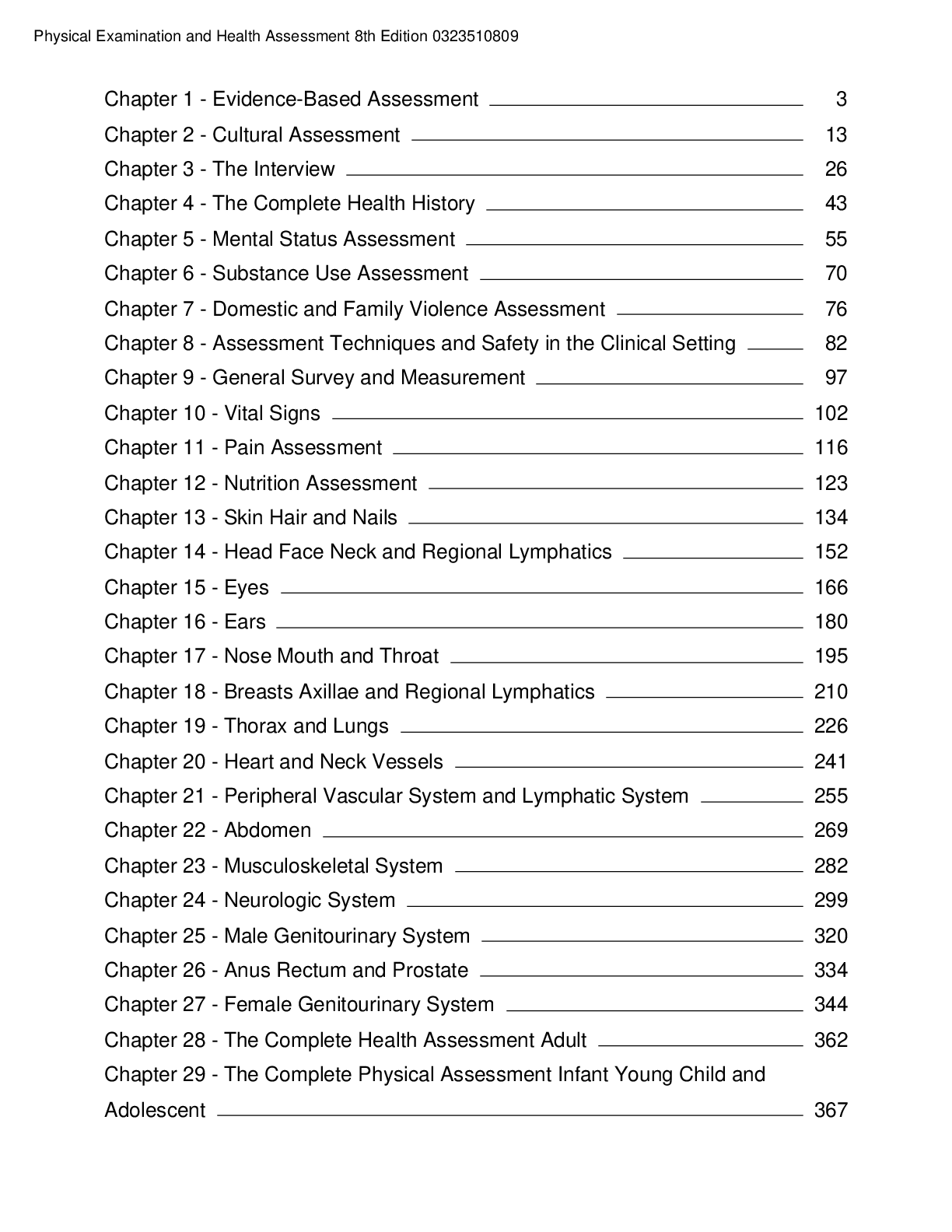
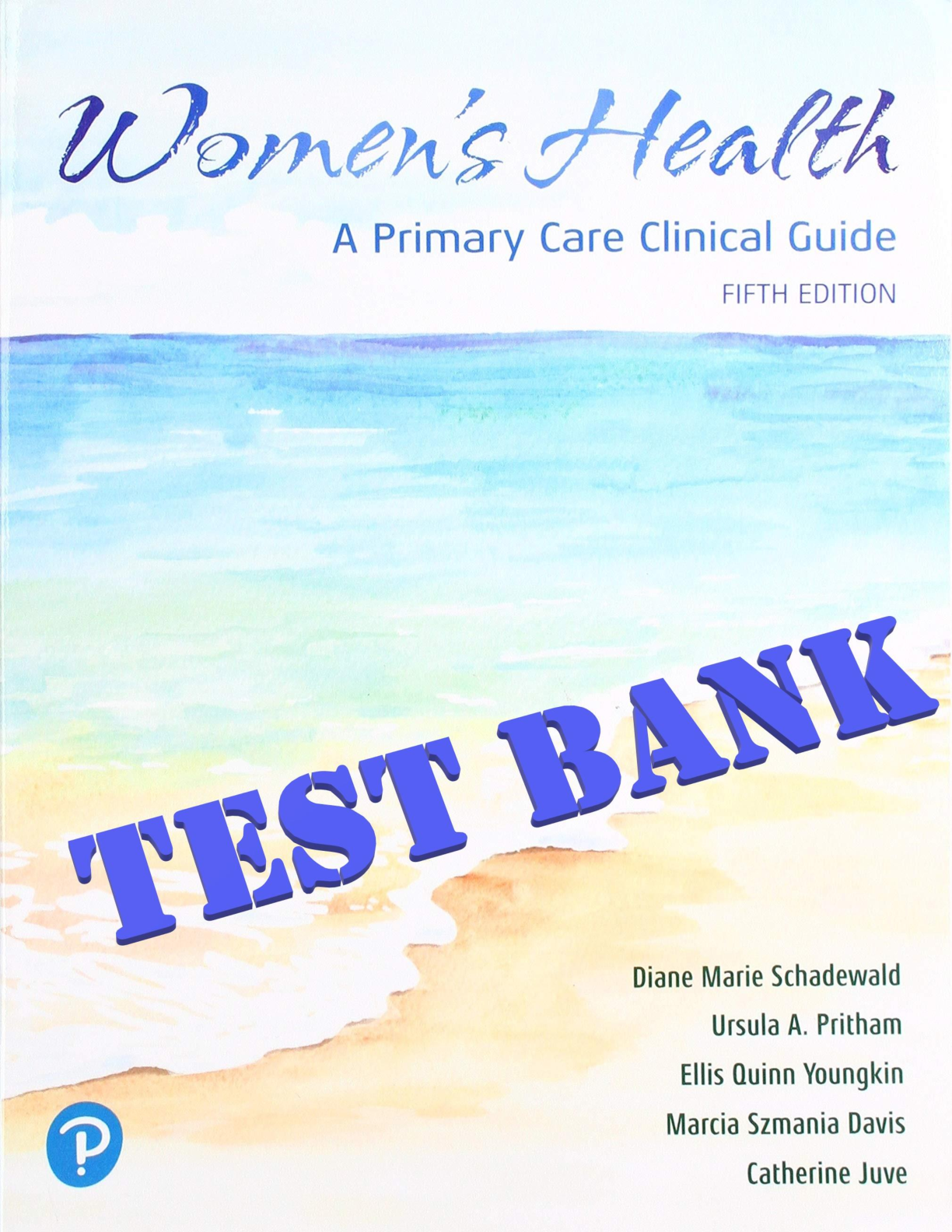
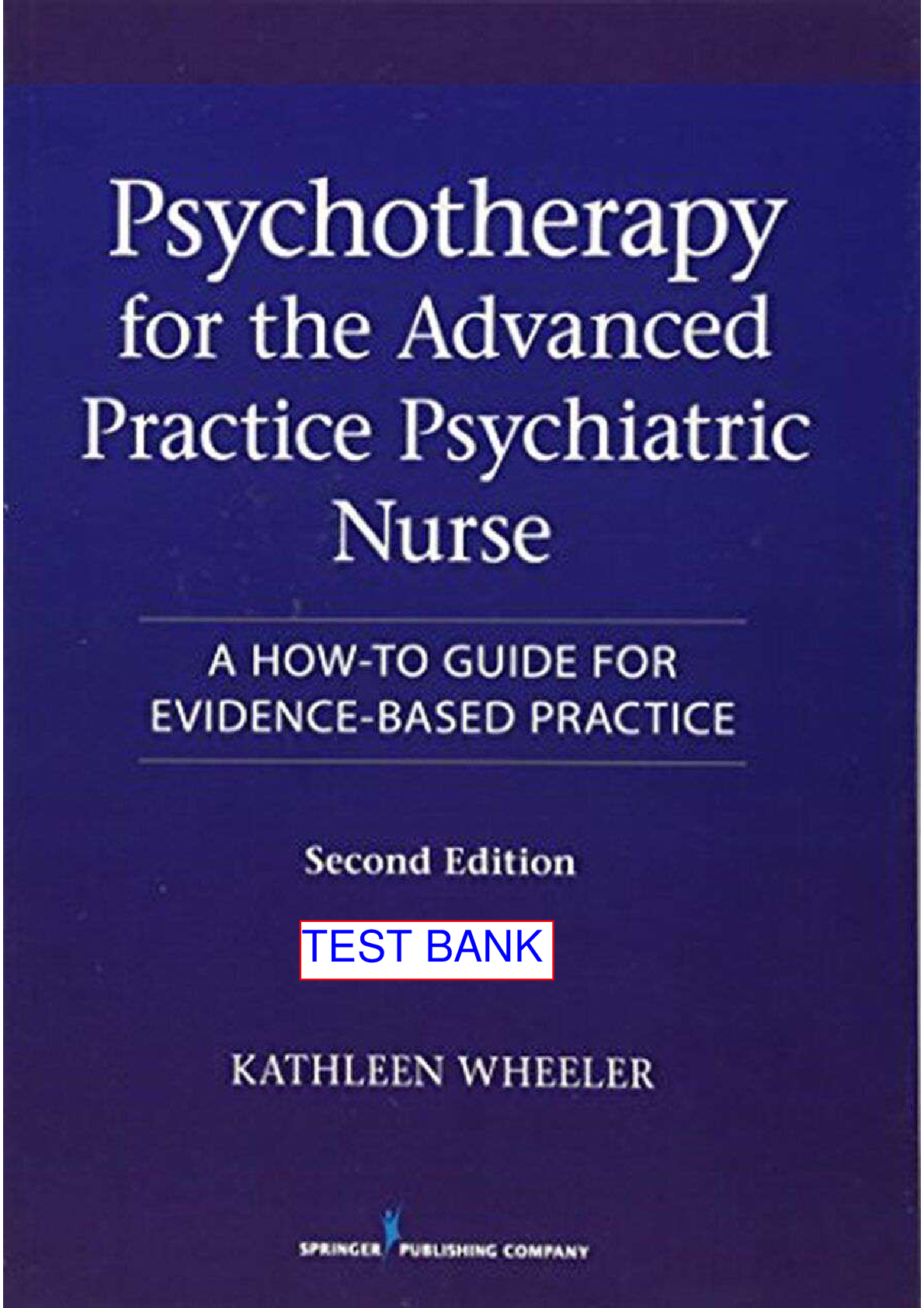
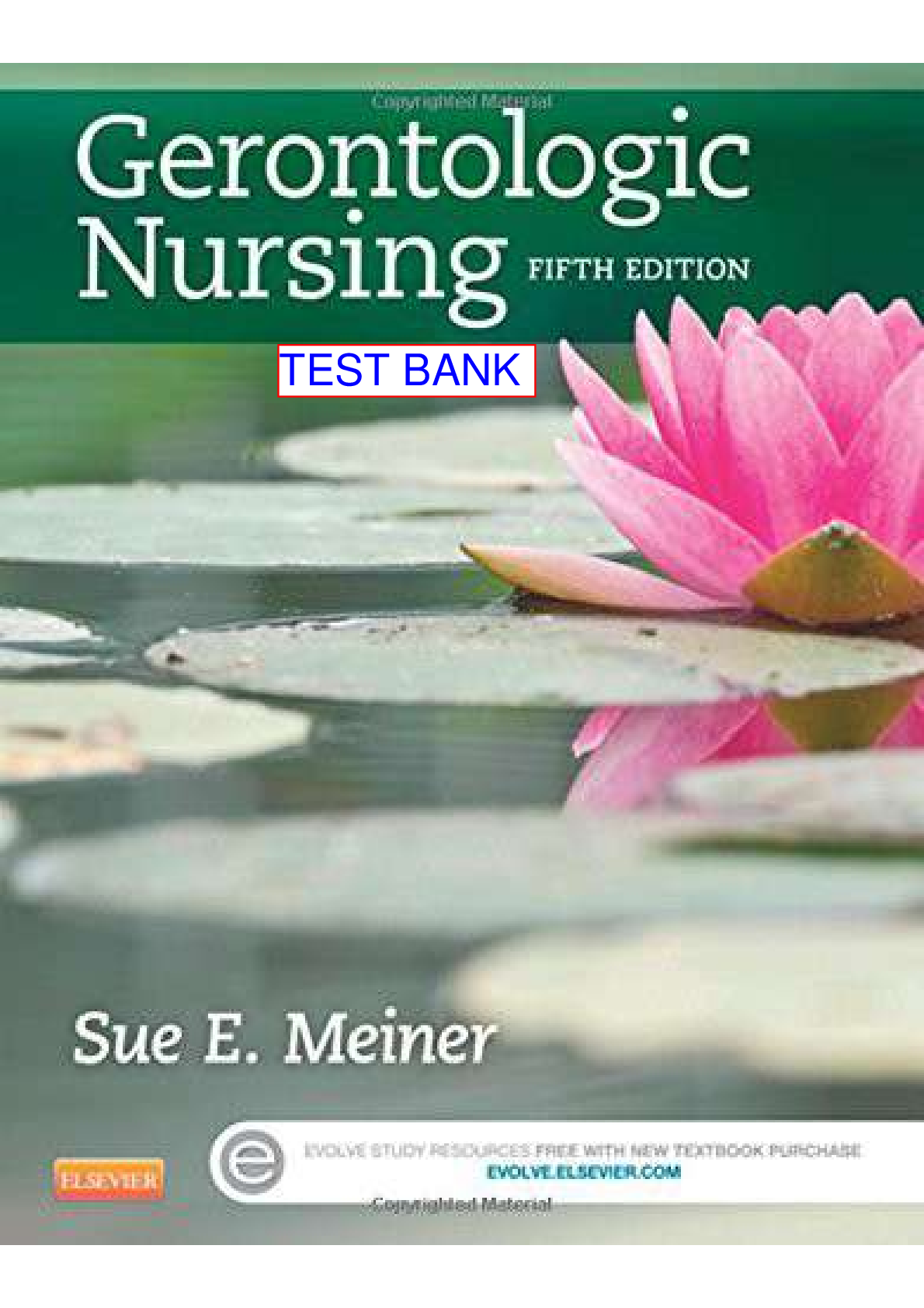

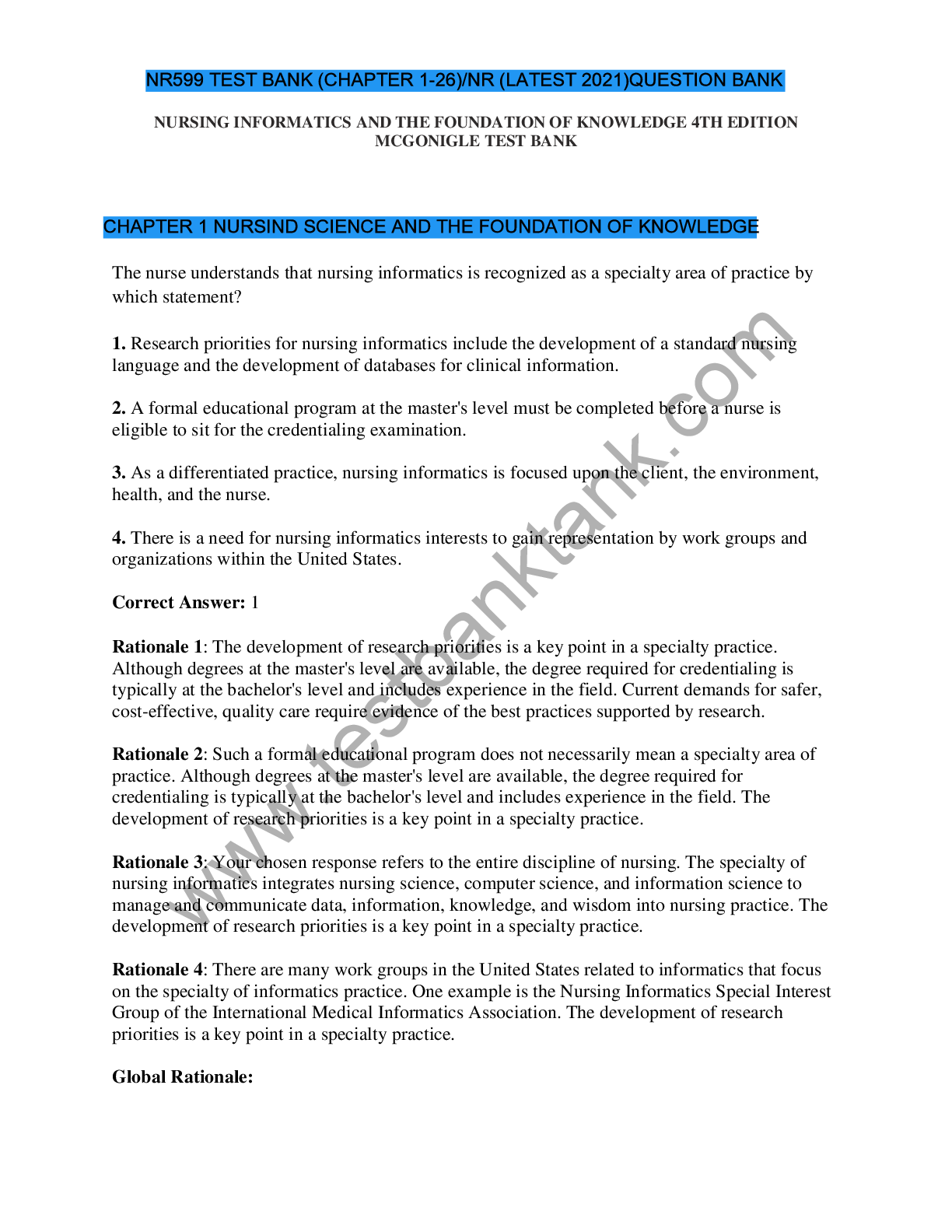
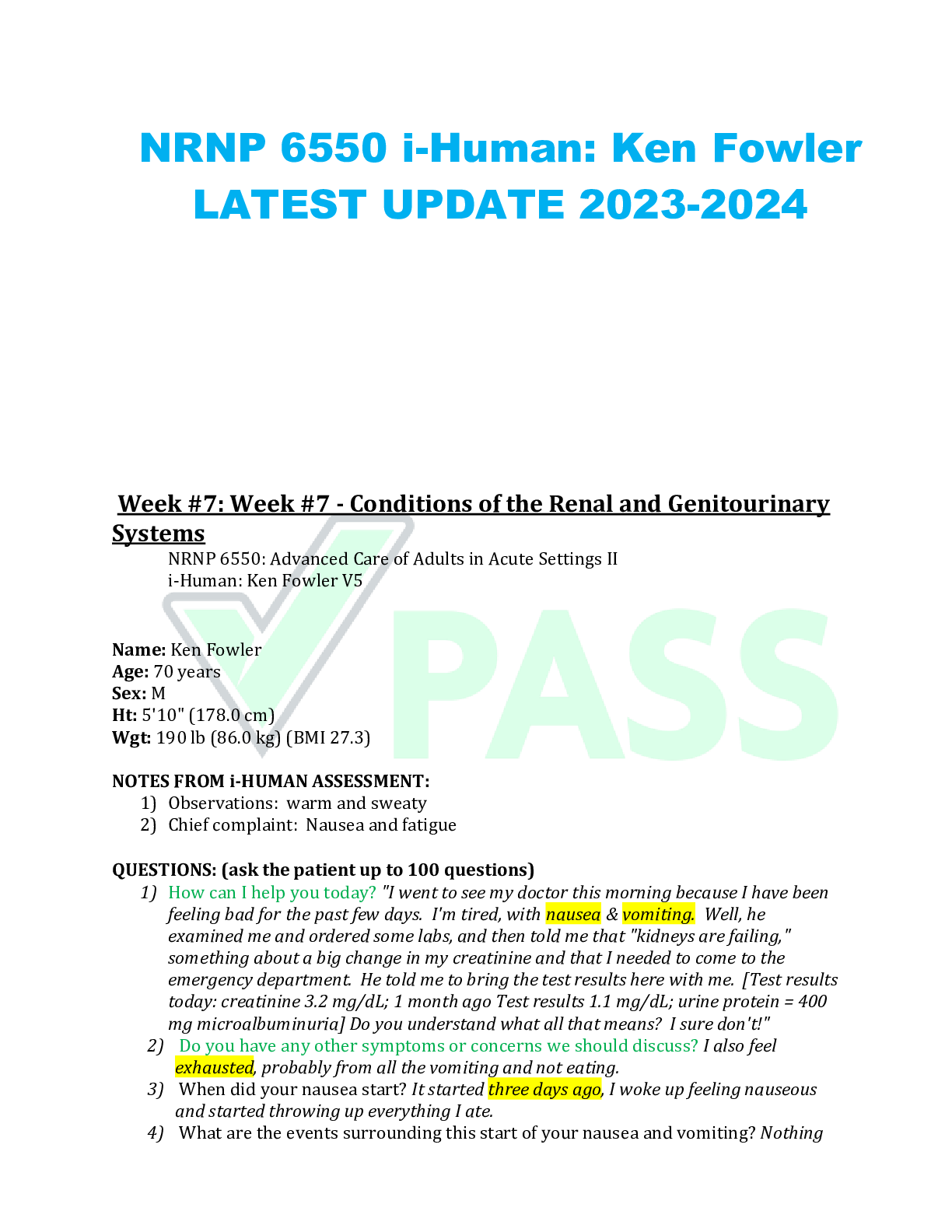
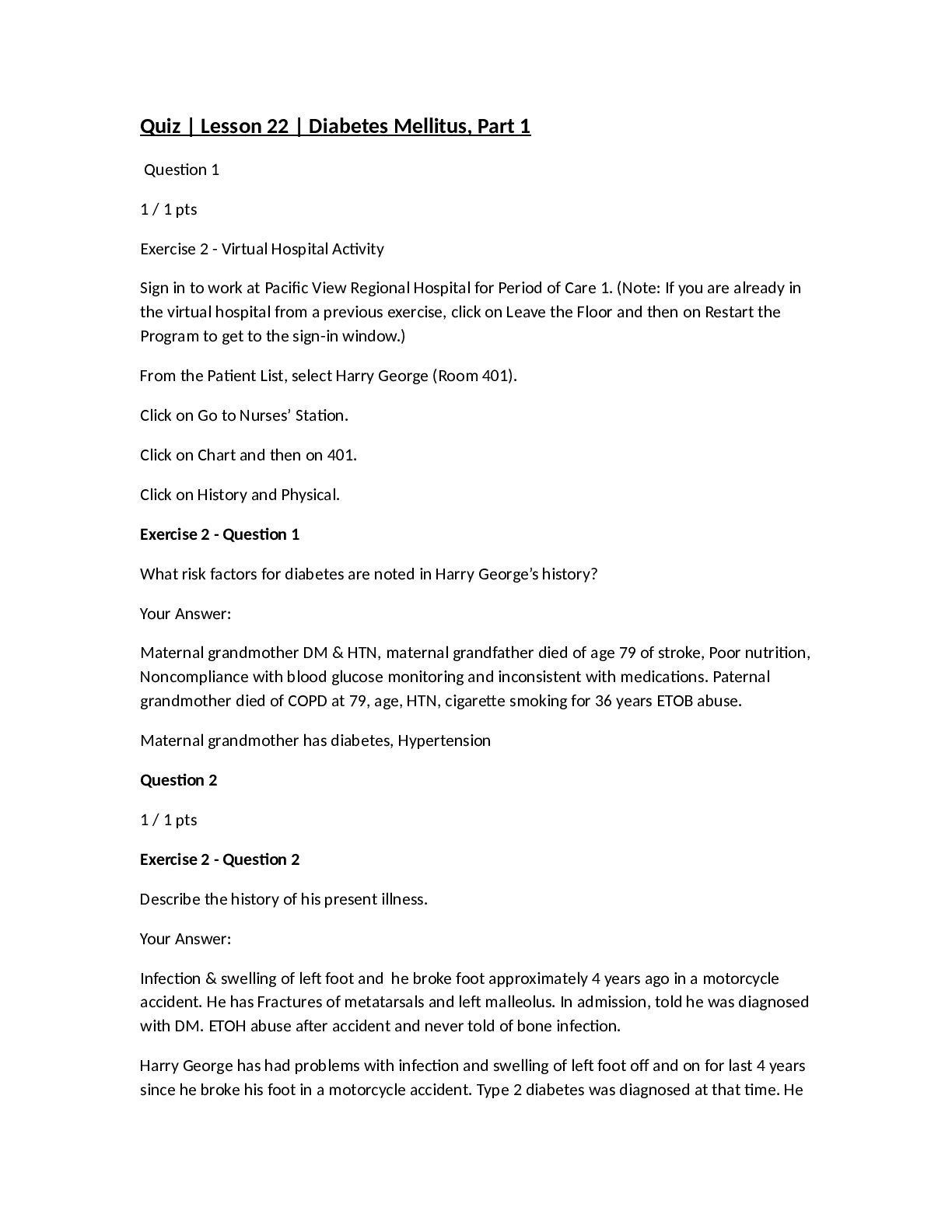
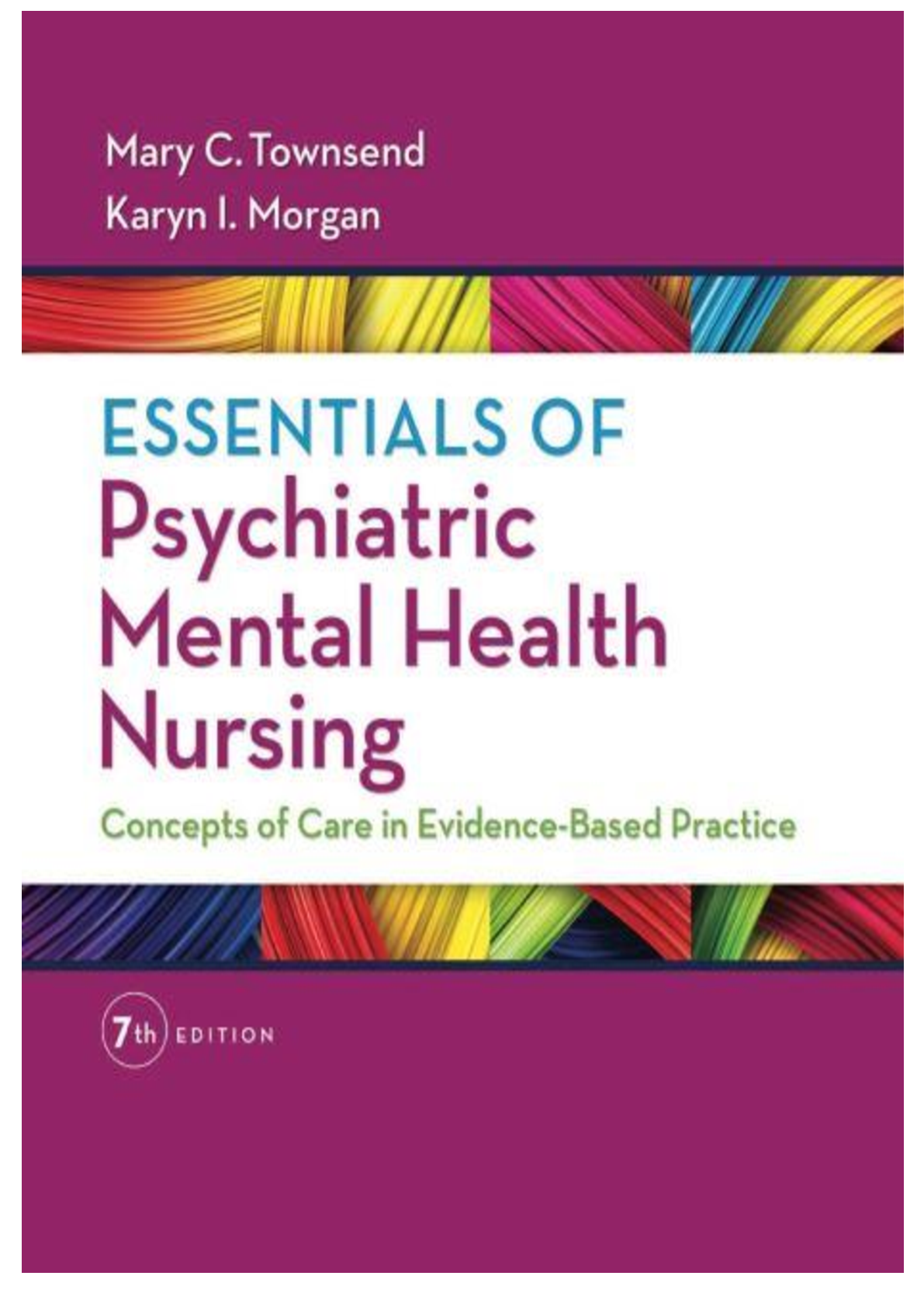
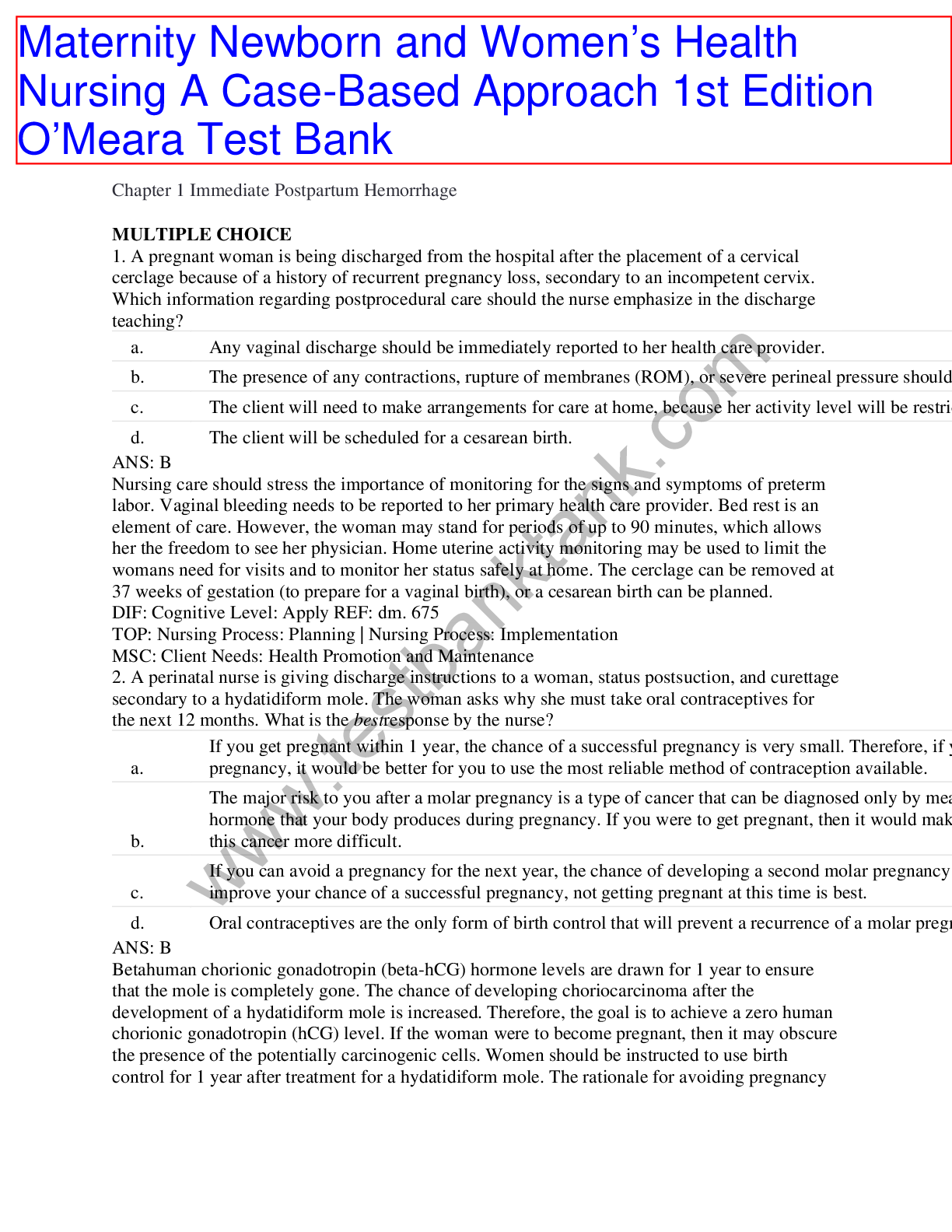

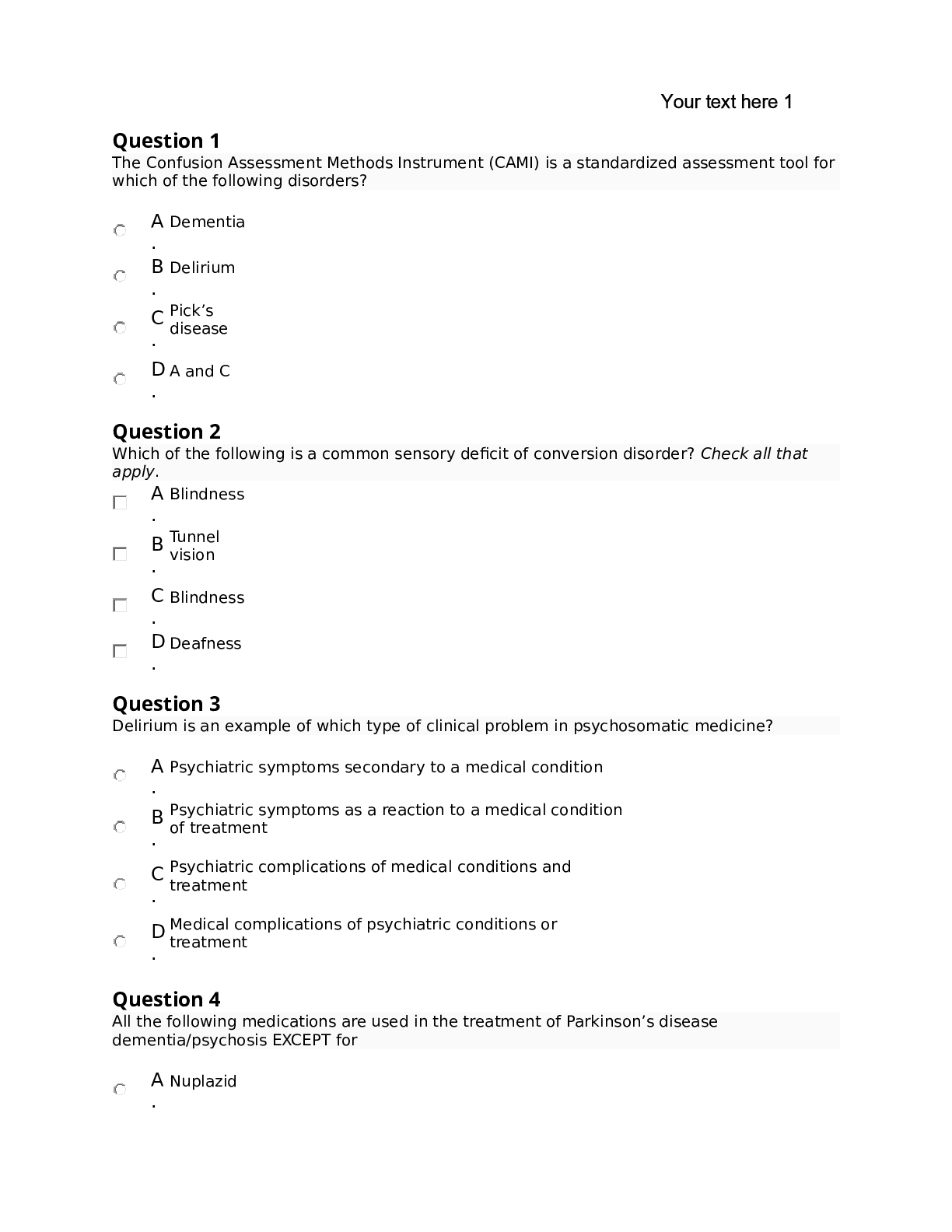
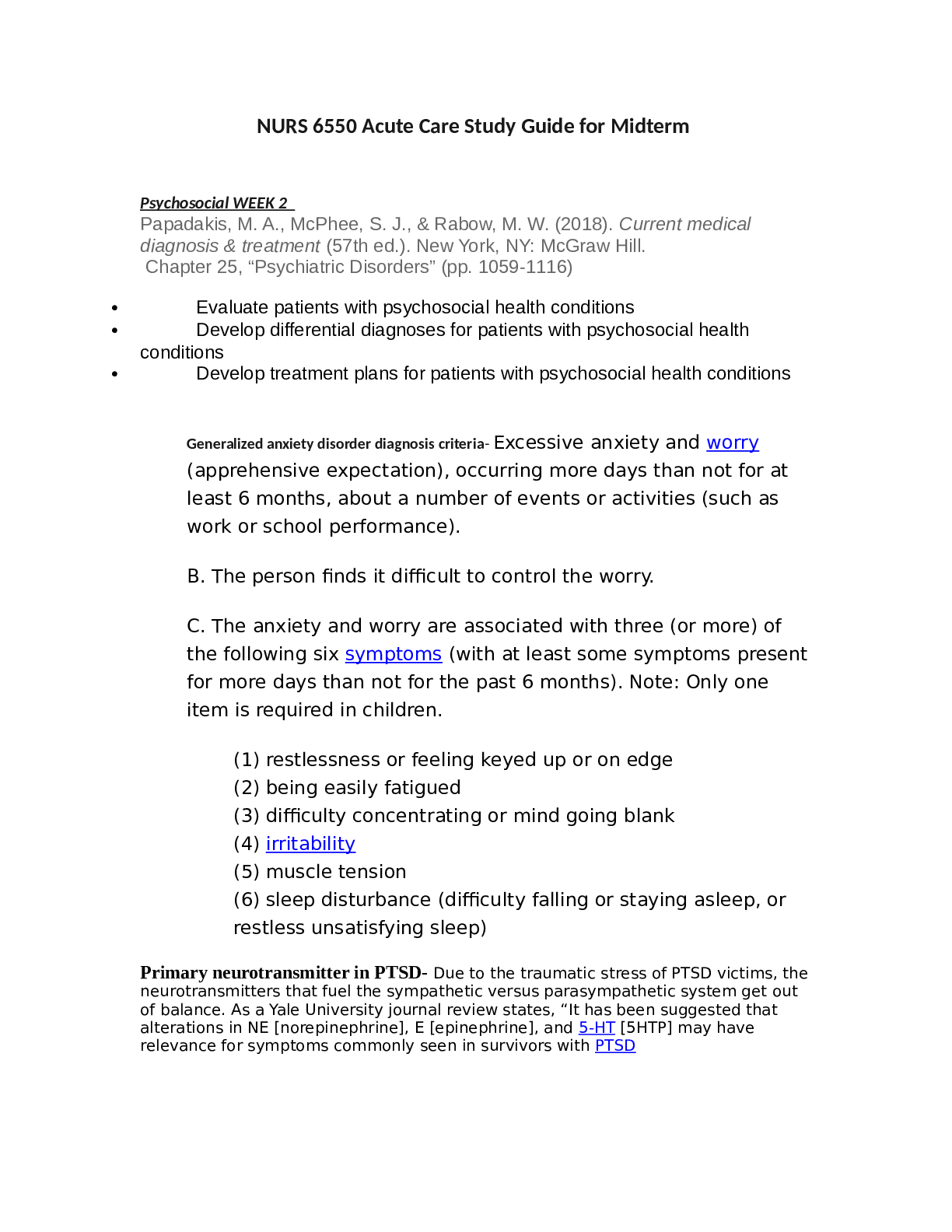
 (1).png)

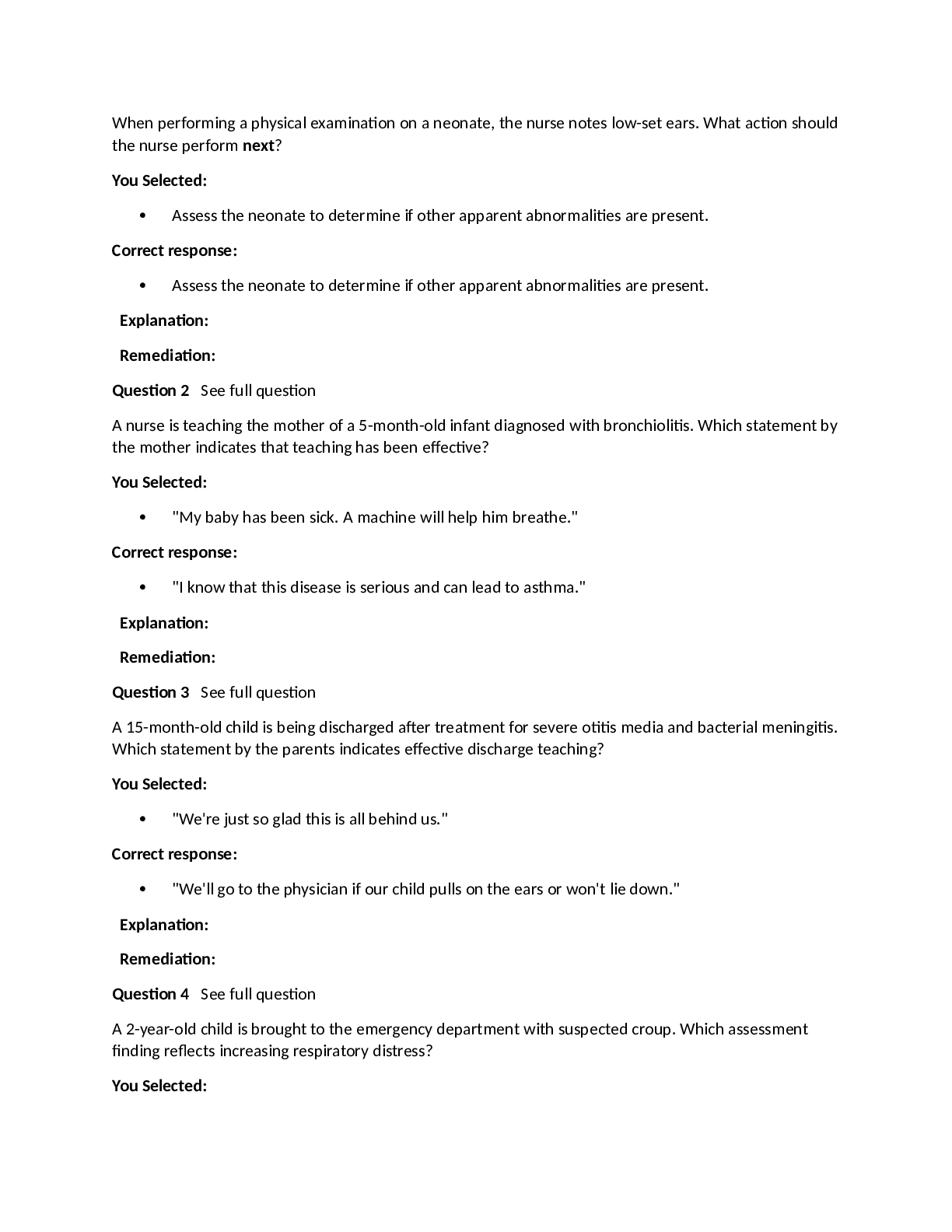
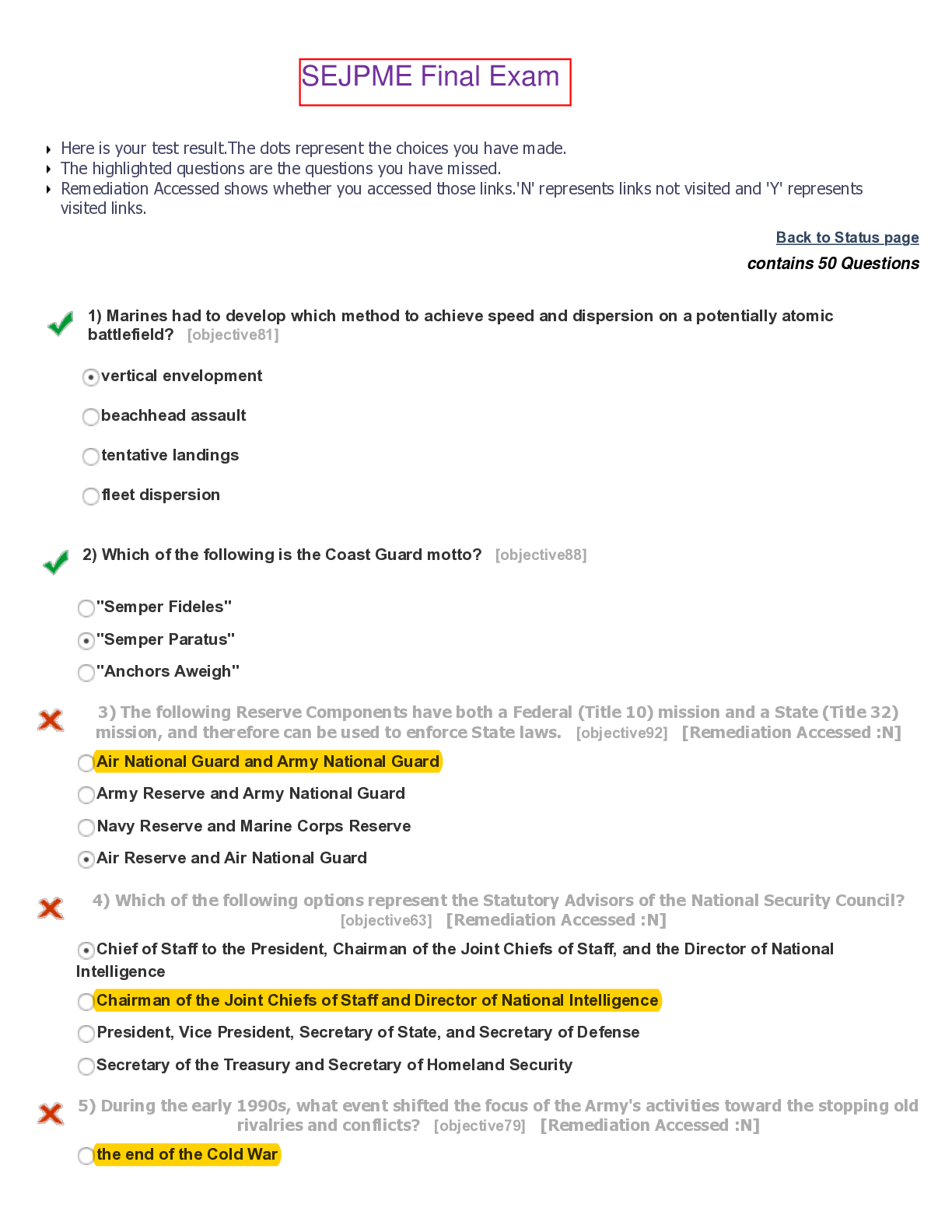
.png)

.png)
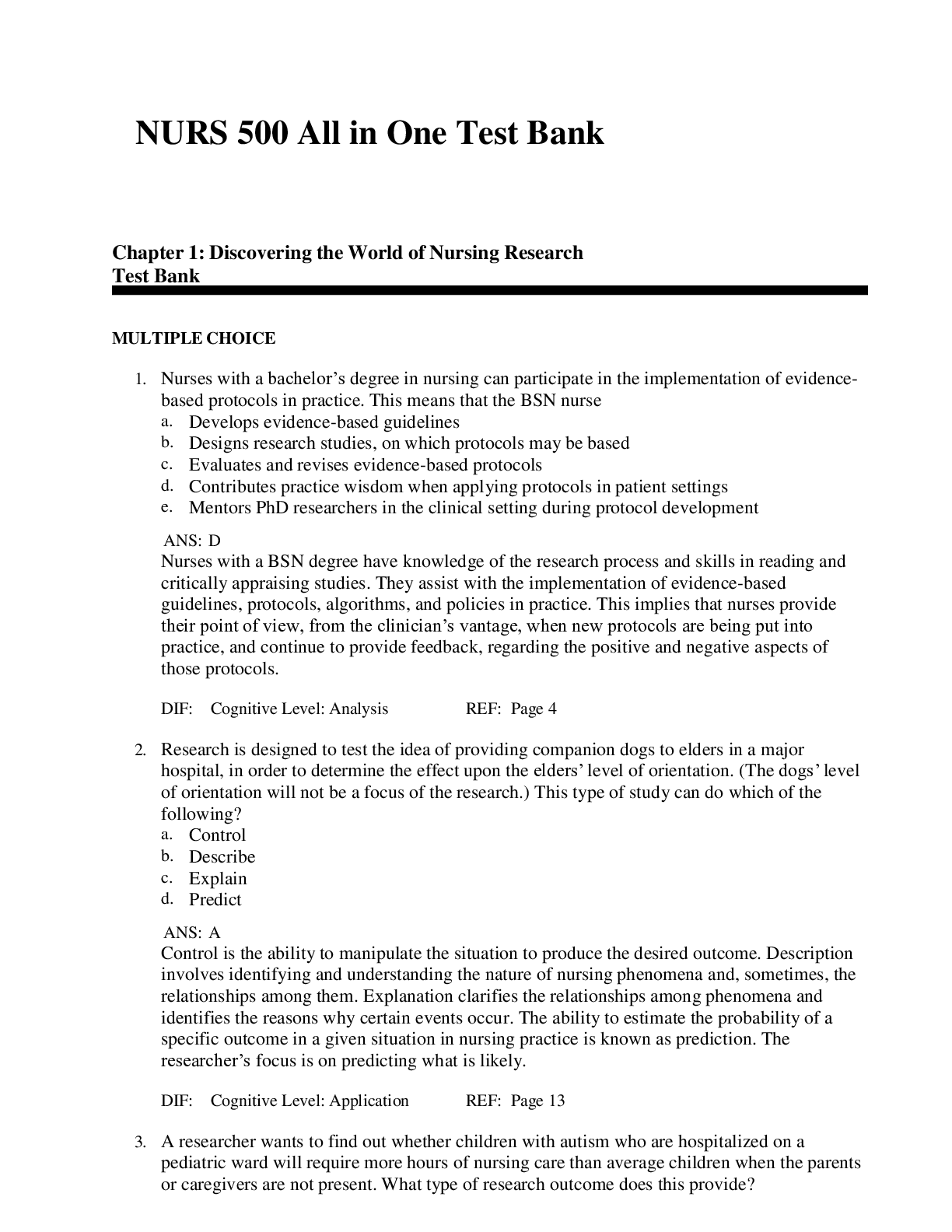

.png)
